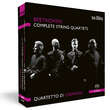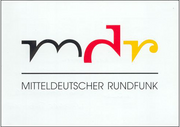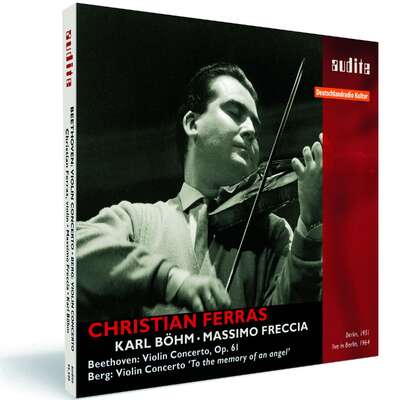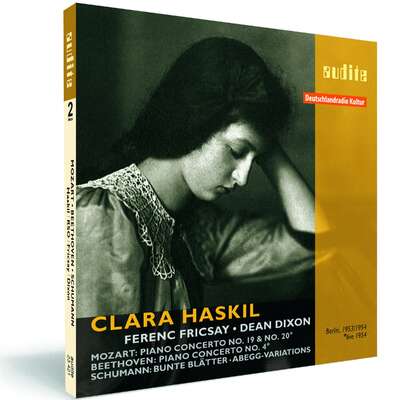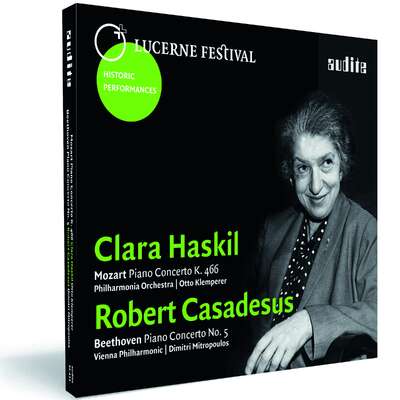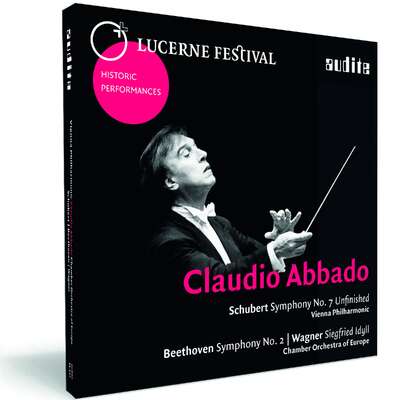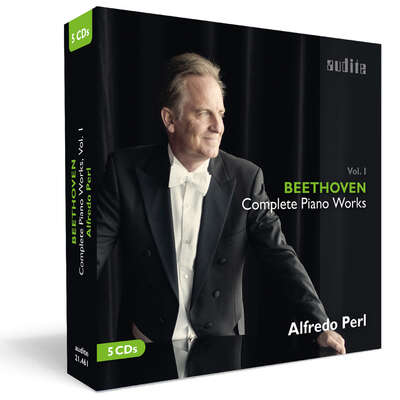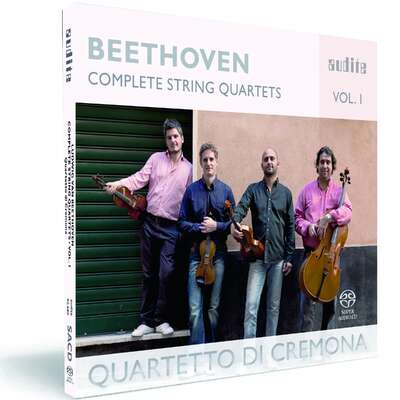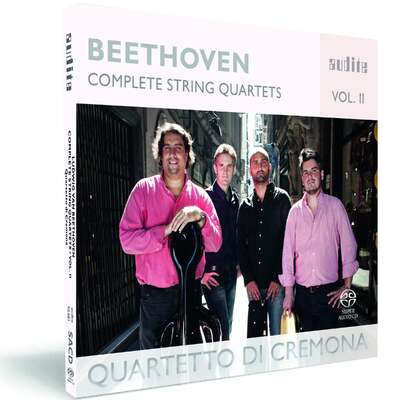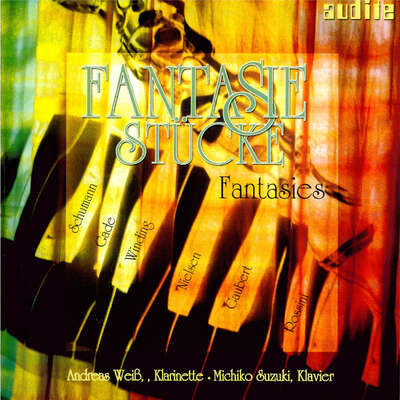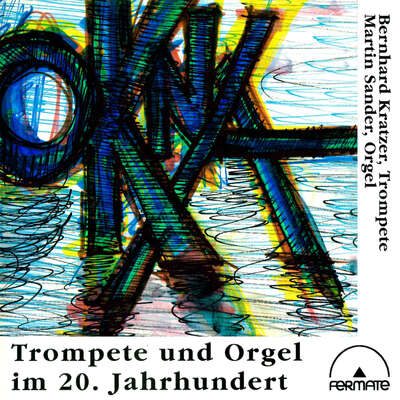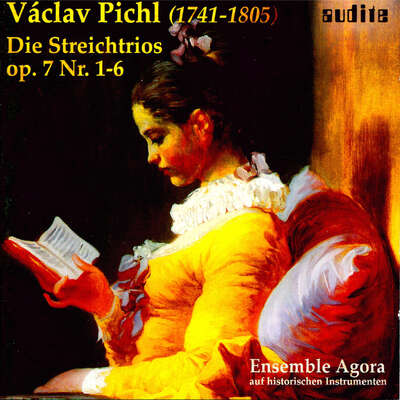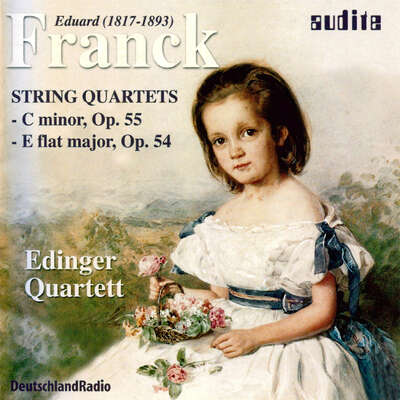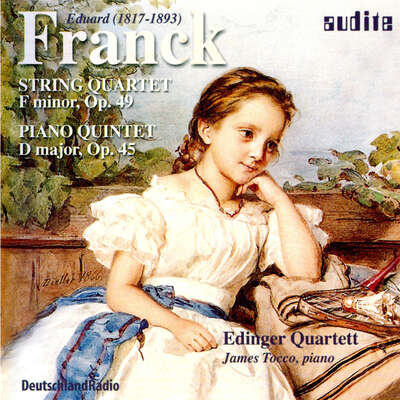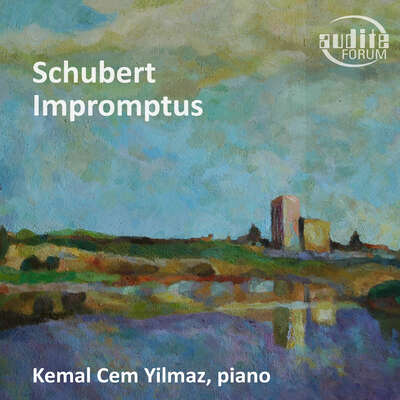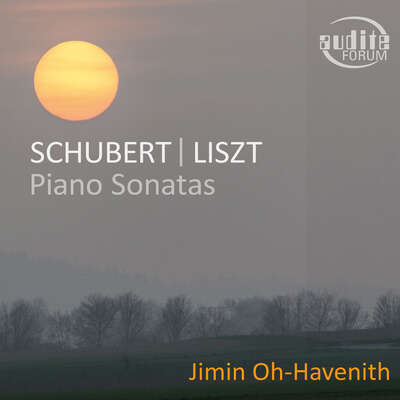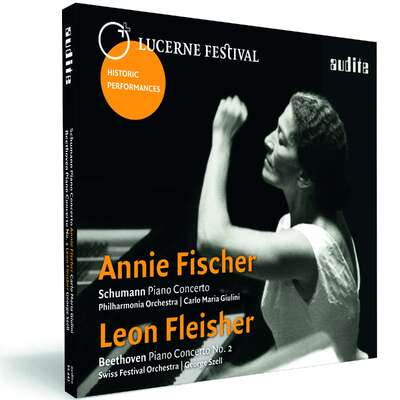
Auto-Rip
Die erfolgreiche Gesamtedition der Beethoven-Streichquartette mit dem Quartetto di Cremona ist nun auch als 8-SACD-Box erhältlich. Die Produktion macht alle Streichquartette des Komponisten zusammen mit seinem Streichquintett op. 29 - dem einzigen originären Werk Beethovens für diese Besetzung - in höchster Qualität zugänglich.mehr
„…Eine sensationelle Gesamteinspielung der Beethoven-Quartette…“ (hifi & records)
Titelliste
Details
| Ludwig van Beethoven: Complete String Quartets | |
| Artikelnummer: | 21.454 |
|---|---|
| EAN-Code: | 4022143214546 |
| Preisgruppe: | BXX |
| Veröffentlichungsdatum: | 8. Juni 2018 |
| Spielzeit: | 543 min. |
Zusatzmaterial
Informationen
Die erfolgreiche Gesamtedition der Beethoven-Streichquartette mit dem Quartetto di Cremona ist nun auch als 8-SACD-Box erhältlich. Die Produktion macht alle Streichquartette des Komponisten zusammen mit seinem Streichquintett op. 29 - dem einzigen originären Werk Beethovens für diese Besetzung - in höchster Qualität zugänglich.
Besprechungen
Note 1 - Neuheitenheft | Weihnachtsbroschüre | 1. November 2019
„Man hat fast den Eindruck, dass die Beethovenschen Quartette zu einer Art Droge geworden sind, die die Cremoneser nicht mehr loslässt“, schreibtMehr lesen
Gramophone | October 2018 | Rob Cowan | 18. Oktober 2018 | Quelle: https://reader.e...
Surveying the stakes of intelligent and insightful Beethoven string quartet cycles by gifted young players finds us with a plethora of recommendableMehr lesen
Mostly Classic | 2018.9 | 1. September 2018
Japanische Rezension siehe PDF!Mehr lesen
Record Geijutsu | Sep.2018 | 1. September 2018 The Record Geijutsu Disc Review
Japanische Rezension siehe PDF!Mehr lesen
www.classicalcdreview.com | September 2018 | R.E.B. | 1. September 2018 | Quelle: http://www.class...
A total of 548 minutes offering a monumental chamber music milestone recorded with a in, natural, resonant sound. Profuse program notes are provided, and the set is mid-price. Essential for chamber music fans!Mehr lesen
Ongaku Gendai | September 2018 | 1. September 2018 Review and Interview
Japanische Rezension siehe PDF!Mehr lesen
De Gelderlander
| 18 aug. 2018 | Maarten-Jan Dongelmans | 18. August 2018 | Quelle: https://www.geld...
Een boxje om mee te nemen naar een onbewoond eiland
Ja, zo gaat dat. Het ene strijkkwartet begint aan een nieuwe Beethovencyclus (zie de aflevering van 15 augustus van deze rubriek) en het andere rondt er een af.
Ook al heb je als kamermuziekliefhebber de Beethovenkwartetten reeds een paar keer compleet in de kast staan, 'Cremona' mag in geen enkele verzameling ontbreken. Het boxje staat garant voor dik negen uur genieten!Mehr lesen
Sächsische Zeitung | Dienstag, 31.07.2018 | Karsten Blüthgen | 31. Juli 2018 | Quelle: https://www.sz-o... Gipfelstürmer aus Italien
In der Geschichte der wichtigsten Kammermusik-Gattung formen die Quartette Beethovens einen Gipfel, der, ähnlich der Sinfonien, singulär geblieben ist. Trittsicher hat ihn das Quartetto di Cremona bestiegen und dabei eine in allen Dimensionen perfekte Balance gefunden.Mehr lesen
http://several-instruments.blogspot.com | Thursday, July 12, 2018 | Dean Frey | 12. Juli 2018 | Quelle: http://several-i... The precision of ideas
I've been keeping an ear on Audite's complete Beethoven String Quartets series with the Quartetto di Cremona as they've been released since theMehr lesen
These are elegant, controlled performances, though without the final burnished sheen of the Amadeus or Alban Berg Quartets. "Without minute neatness of execution," William Blake once said, "the sublime cannot exist! Grandeur of ideas is founded on precision of ideas." The "final minute neatness" is not here, or at least not all the time, though that neatness would in an case wear a bit thin through a full nine hours of music. The string quartets of Beethoven go on a meandering voyage through his own messy life, from his early days nearly to his death. This music, which began in the candle-lit salons of the Ancien Régime, emerges in the worlds of fashion and celebrity that made him a household name throughout Europe, and comes to an end in the squalor, regret and frustration of his final years. It's all too real to have the same Platonic existence of the music of Bach, though that doesn't make it any less grand, or sublime, in the Blakean sense. The Cremona musicians connect with this real-life Beethoven, his folk-song references, musical jokes and sentimental tags. And yet they're still able to bring a nearly full account of the soaring genius of the late quartets. Consider the Quartetto di Cremona a reliable guide to one of the greatest of all musical journeys.
Intoxicate | 06.07.2018 | 6. Juli 2018
Japanische Rezension siehe PDF!Mehr lesen
www.opusklassiek.nl | juni 2018 | Aart van der Wal | 1. Juni 2018 | Quelle: https://www.opus...
Het enige wat soms net nog lijkt te ontbreken zijn de rondspattende kanonskogels en het oorverdovende geweervuur. [...] Het zijn zomaar wat overwegingen die opborrelden tijdens de beluistering van deze set die indruk maakt, maar waarin bijna tomeloze ‘Sturm und Drang' en bij tijd en wijle zelfs anarchie (op. 18) de boventoon voert. Uitbundigheid overstijgt precisie (de hoekdelen van op. 59 nr. 1) en de intensiteit van dit spel doet de structuur menigmaal zelfs in zijn voegen kraken (op. 133). Mehr lesen
The Strad | January 2018 | Julian Haylock | 1. Januar 2018 The Cremona's Beethoven project hurtles towards an exciting climax
The Cremona Quartet completes its Beethoven series with a fine coupling,Mehr lesen
Fono Forum | Januar 2018 | Marcus Stäbler | 1. Januar 2018
Die Gesamtaufnahme aller Beethoven-Streichquartette war für das Quartetto di Cremona mehr als ein musikalisches Anliegen. "Wir möchten zeigen, dassMehr lesen
In der Tat präsentiert sich das Quartetto di Cremona im Beethoven-Zyklus als hervorragender Botschafter der italienischen Quartett-Kultur und untermauert zugleich seine eigene Position als Ensemble der internationalen Spitzenklasse. Mit einem hohen interpretatorischen Niveau, das auch die achte und letzte Folge prägt.
Sie vereint das mittlere Quartett op. 74 mit dem Quartett op. 18/3, das von manchen Formationen vielleicht einen Tick zu leicht und verspielt genommen wird. Dagegen geben die italienischen Streicher dem Stück etwas mehr Gewicht als oft üblich und finden auch hier, wie bei allen ihrer Beethoven-Interpretationen, einen eigenen Zugang. Der manifestiert sich etwa in den Akzenten im Kopfsatz, die sie schon ziemlich rau herausschießen lassen und in den Achtelfiguren gleich zu Beginn, die nicht als bloßes Beiwerk erklingen, sondern mit einer starken Ausdrucksenergie aufgeladen sind.
Dieses expressive Spiel gehört zu den Markenzeichen des Ensembles und beseelt etwa das Andante con moto mit einem innigen Sotto-Voce-Gesang, während im Finale die spritzige Virtuosität der vier Italiener aufblitzt. Mit ihrem lebendigen Zugriff schärfen sie die Charaktere von Beethovens Musik. Auch im Es-Dur-Quartett op. 74, in dem sie etwa den Kontrast aus neckischen Pizzicati – die dem Stück seinen Beinamen "Harfenquartett" beschert haben – und gestrichenen Sforzati herausstellen. Oder im Presto, dessen Oktavmotiv sie kantig in die Saiten meißeln, bevor ein facettenreicher Variationssatz die SACD und das ganze Projekt beschließt.
Mitteldeutscher Rundfunk | MDR KLASSIK | Das Werk | 27. Dezember 2017 | 14:05 Uhr | Alexander Gosch | 27. Dezember 2017
BROADCAST
Beethovens Streichquartette
Zum Abschluss seines großen Beethoven-Zyklus' hat das Quartetto di CremonaMehr lesen
concerti - Das Konzert- und Opernmagazin | 27. Oktober 2017 | 27. Oktober 2017 | Quelle: https://www.conc...
Eindrucksvoll interpretiert
ECHO Klassik 2017: Quartetto di Cremona
Völlig unbeschwert, aber mit einer gehörigen Portion italienischer Leidenschaft und dem leichten Lebensgefühl des „dolce vita“ musizieren die vier Streicher [...] mit ihrem, mal elegant-strahlendem, mal tiefgehendem, fast schon sprödem Quartettsound. [...] das Quartetto di Cremona durchdringt das Quartettwerk Beethovens auf eine beeindruckende Weise.Mehr lesen
Crescendo | Sonderedition ECHO KLASSIK, 06/2017 Oktober-November 2017 | 1. Oktober 2017
Der ganze vielfältige Beethoven
Das Quartetto di Cremona legt mit der siebten Folge aller Beethoven-Quartette das Spannungsfeld von Wiener Klassik und neuer Klangwelt frei
Vor 17 Jahren hat sich das Quartetto di Cremona gegründet, und was esMehr lesen
hifi & records | 4/2017 | Uwe Steiner | 1. Oktober 2017
Als Werbeveranstaltung der Tonträgerindustrie interessiert mich derMehr lesen
www.concerti.de
| 1. Oktober 2017 | Johann Buddecke | 1. Oktober 2017
Gelungener Abschluss
Der insgesamt schlanke, fast schon zarte Klang des Quartetto di Cremona bestimmt den Grundtenor dieser Einspielung
Als Abschluss ihres Beethoven-Zyklus’ widmet sich das bisweilen schon alsMehr lesen
concerti - Das Konzert- und Opernmagazin | Oktober 2017 | Maximilian Theiss | 1. Oktober 2017
Kunst der Unterhaltung
ECHO KLASSIK: Weitere Preisträger
Kammermusikeinspielung (Musik bis 19. Jh. | Streicher)<br /> Kürzlich wurde der Zyklus mit Beethovens Streichquartetten vollendet, geehrt wird nun aberMehr lesen
Kürzlich wurde der Zyklus mit Beethovens Streichquartetten vollendet, geehrt wird nun aber die vorletzte Einspielung der Gesamtaufnahme.
Kürzlich wurde der Zyklus mit Beethovens Streichquartetten vollendet, geehrt wird nun aber
www.pizzicato.lu | 22/09/2017 | Guy Engels | 22. September 2017 Packend bis zur letzten Note
Geschafft! Nach vier Jahren hat das ‘Quartetto di Cremona’ seinen Marathon mit sämtlichen Beethoven-Quartetten triumphal beendet. Den vierMehr lesen
Getreu seinem bisherigen Konzept hat das ‘Quartetto di Cremona’ ein Frühwerk mit einer reiferen Komposition konfrontiert, wobei der Begriff Frühwerk hier zu Recht ‘ad absurdum’ geführt wird.
Das dritte Quartett aus dem Opus 18, mit dem das Programm eröffnet wird, zeigt nämlich bereits die volle dramaturgische Wucht von Beethovens Musik, die die Interpreten auch in dieser Aufnahme entfalten. Der verspielten Leichtfüßigkeit und dem melodischen Charme verpassen sie immer wieder scharfe Kanten. Die Musiker spielen mit Erwartungen des Hörers, erzeugen Spannungen, die sie stets gekonnt brechen – sehr oft in einem ausgeklügelten Spiel mit den Tempi.
Im Opus 74, dem sogenannten Harfenquartett, fasziniert einmal mehr die zupackende Art des ‘Quartetto di Cremona’, die in ein vibrierendes, hoch emotionales Musizieren mündet. Als Zuhörer folgt man gebannt, ist man gefesselt: Die Musik lässt nicht los. Mehr kann man von Interpreten eigentlich nicht verlangen!
Quartetto di Cremona finishes their outstanding Beethoven cycle with vibrant and highly passionate performances.
BBC Music Magazine | September 2017 | Erik Levi | 1. September 2017
The Quartetto di Cremona's ongoing Beethoven cycle has particularly impressed me for its visceral excitement and pulsating energy. Technical demandsMehr lesen
Another strength is their consummate mastery of soft mysterious playing, experienced here to best advantage in the unexpectedly veiled sounds they conjure up just before the recapitulation to the first movement of Op. 18 No. 2, or in the harmonically radical slow introduction to Op. 59 No. 3, where they manage to stretch tension and uncertainty to almost breaking point before the exuberant release of an unequivocal C major tonality in the ensuing Allegro vivace.
Yet for all their undoubted qualities, these performances miss certain ingredients that are also central to Beethoven's musical make-up, in particular charm and humour. The outer movements of Op. 18 No. 2 are a good case in point. In the opening Allegro, for example, the Quartetto di Cremona convincingly projects the sudden explosive fortes, but the principal melodic lines seem somewhat devoid of grace and elegance. Likewise, for all its brilliance of execution, the performers underplay the sheer impudence with which Beethoven changes to distant keys in the skittish Finale. In general, therefore, the more expansive Op. 59 No. 3 is better suited to the Quartetto di Cremona's approach.
deropernfreund.de | 24.8.2017 | Egon Bezold | 24. August 2017 Edle kammermusikalische Kost
Welches Quartett kann es sich schon leisten am Mikrokosmos der Beethoven-Streichquartette vorüberzugehen? Die komplette Edition hat das Cremona TeamMehr lesen
Simone Gramaglia meldet sich in den Mittelstimmen zu Wort. Mit Klang und Kraft bedient Giovanni Scaglione den Cello-Part. Was die Vierertruppe auszeichnet ist die artikulationskräftig erfrischende Art wie der Quartett-Text verdeutlicht wird, ohne dass jemand auf den Gedanken käme allzu deutlich mit dem didaktischen Zeigefinger aufzuzeigen.
Voller Überraschungen steckt die Wiedergabe der frühen sechs Quartette aus op. 18, die aufgrund der stilistischen Problematik mit zu den vertracktesten des Quartett-Zyklus zählen. So flitzen die schnellen Sätze als Kabinettstücke in spieltechnischer Präzision vorüber. Flexibel reagiert die Viererformation auf die Stimmungsumschwünge. Schlüssige Tempi markieren den Pulsschlag einer glutvollen Wiedergabe. Da wird nicht nur der Geist Haydns und Mozarts geweckt, sondern auch der mittlere und späte Beethoven vorausgedacht. Den klingenden Beweis liefern die kurzangerissenen Akkorde aus dem c-Moll op. 18,4. Auch das heikle Quartett op.18,5 gerät zum spannungsgeladenen Akt für fein ziselierte, nervig rhythmisierte Quartettkunst.
Hohe interpretatorische Intelligenz charakterisiert die Wiedergabe der mittleren Werkgruppe op. 59. Als eminent schweres Prüfstück erweist sich für die Primgeige das e-Moll Nr. 2, das Günther Pichler, der Ex-Primarius des Alban Berg Quartetts, als vertrackter als den Solopart des Beethoven-Violinkonzerts charakterisiert hat. Und es stimmt alles: die Spieltechnik, die sensibel ausgeschriebenen Übergänge, auch die vibrierenden Sechzehntelpassagen, die in der sich verflüchtenden Atmosphäre zu Tage treten. Welch fein abgetönte Stimmung prägt das ruhig genommene, breit ausgespielte „Adagio con sentimento“, das vorbildlich ausgewogen im Ausdruck fasziniert. Atem nehmend die akrobatische Fuge aus dem dritten Quartett, die selbst für ein professionelles Team eine Hürde darstellt. Dass dieser Sturmlauf wohl zum radikalsten gehört, was in der Sektion „Perpetuum mobile“ geschrieben wurde, machen die Cremona Leute klangartistisch zur Hetzjagd nach Noten.
Zur klanglichen Delikatesse gerät das Finale des ersten Satzes aus dem „Harfenquartett“ op. 74. Unwirsch springt einen das f-Moll Quartett op. 95 ins Gesicht. Da wird der musikalische Trotz buchstäblich auf die Spitze getrieben. Der große Gipfelsturm auf die Monster der späten Quartette, wo sich Spiritualität und geistiger Anspruch auf faszinierende Weise durchdringen, beginnt mit dem Es-Dur Quartett op. 127. Organisch gelingt die Darstellung, nirgends wird der natürliche Strom der Musik unterbrochen. So gewinnt das endlos fließende durch subtiles Variationenwerk angereicherte Adagio troppo, molto cantabile durch Ausspielen der harmonischen Reibungen besonders an Leuchtkraft. Dieser ausladende Satz wird mit viel Innenspannung aufgeladen. Da ist ein Auseinanderbröckeln ausgeschlossen. Mit welcher Reaktionsfähigkeit das Team die Stimmungsumschwünge realisiert, macht Staunen. Zum Quartett-Komplex zählt auch die Große Fuge B-Dur op.133 – ein nachkomponierter Bestandteil, der 6. Satz der Originalversion des Quartetts op. 130. Zu bewundern ist auch im a-Moll op. 132 der wunderbar ausgespielte „Heiliger Dankgesang eines Genesenden an die Gottheit“. Energisch durchgeformt erscheint das Alla marchia des vierten Satzes und die fulminant hoch wirbelnde Final-Stretta.
Die suitenartig aneinander gereihten Abschnitte im cis-Moll Quartett op. 131, die Beethoven ja auf das Komplizierteste nahtlos miteinander verzahnte, stiften überzeugende Einheit. Da werden die durchsichtig gespielten Details, die liberal behandelte Sonate nie aus dem Auge verloren. Im ersten Allegro kommen die Akzente konturenscharf. Innere Ruhe verströmen die schier endlos sich hin dehnenden Variationen. Es gibt keine Stimmenkorrespondenz, keine rhythmische Spannung, kein dynamischen Ansatz, über die vom Vierer Team flüchtig hinweg gespielt worden wäre. Von bohrender Kraft und beispielhaftem Standvermögen kündet der Finalsatz.
Diese exemplarische Auslegung bannt die Tontechnik auf das Format „Souround Sound – spielbar auf CD und SACD Player“. Das kammermusikalische Profil öffnet reizvolle kompositorische Perspektiven, vermittelt einen tiefen Einblick in Beethovens kammermusikalische Meisterschaft. Schulbildend für die Cremona Gruppe ist der Deutsch-Österreichische klassisch geprägte Stil (in Bezug auf Werktreue, Form und Stil) wie von Hatto Beyerle vom Alban Berg Quartett und in Fortsetzung von Piero Farulli vom Quartetto Italiano gepflegt wurde. Hier verbinden sich ein leidenschaftlich-emotionaler Ansatz mit romantisch geprägten Elementen sowie italienischer klanglicher Ästhetik. Da verschmelzen Struktur, Ausdruck und Form zur glühenden inneren Leidenschaft.
Fanfare | June 2017 | Huntley Dent | 1. Juni 2017
Reviewers live with the frustration of how to convey music verbally, a frustration underscored by the Quartetto di Cremona. This is Vol. 7 of itsMehr lesen
It was far from a simple topic to Gramaglia: “[Vibrato] is a matter of the performers’ taste but also of structure….In op. 59 no. 2 there are many sections in E minor that are very dark but not as dark as, for example, in the tonality of C minor. There are many extremes of violence, and it’s very important to bring brightness into the darkness.” Brightness is interpreted as calling for no vibrato in this case. Gramaglia goes on to talk about how expressivity doesn’t necessarily mean the use of vibrato; there is a wide range of bowing techniques as well as the contract point of the bow on the string that must be considered.
The interviewer is intrigued by the PR blurb for the same recording, which says, “Beethoven’s musical language is no longer balanced and ‘well seasoned’ like that of his contemporaries but is extreme in every respect—ruthless and with feeling, dramatically operatic, and full of contrapuntal finesse.” It’s very promising that so much analytical attention is being applied to middle-period Beethoven (I’ve barely skimmed the surface of the interview), and the resulting performance on this new recording of the “Razumovsky” Quartet No. 3 is original to the point of being peculiar. As much ingenuity is applied to the details of sonority as if we were hearing one of Bartók’s later quartets. In fact, I’ve never encountered Beethoven played in such a piercing, at times existential, hollow, despairing, and alienated manner. Delivering a moment of charm is almost a betrayal of the ethos the Quartetto di Cremona wants to convey.
Typically, a group that plays the drawn-out chords of the Introduzione without vibrato would be making a period performance gesture. Here, however, the effect is stark, a slash-and-burn that is unabashed. But then what to do when the main Allegro vivace, with its boisterous major-key exuberance, contradicts the opening? The same dilemma arises in the second movement, where a certain poised lightness is implied by the marking Andante con moto quasi allegretto. The Cremona rocks back and forth with a questioning pulse that’s neurotically moody. Once again it’s very effective, but the gentle strain that comes up in the violins isn’t remotely this eerie as Beethoven scores it.
One can point to many imaginative details—they crop up in practically every measure—and after a certain point the listener must either give in or rebel. I find myself strongly on the side of giving in and appreciating with fascination how a familiar work is suddenly made to sound new. The Cremonas have made the point in print that Beethoven’s mature quartets are highly intellectual and deserve this kind of intense scrutiny. The scherzo creeps in on cat’s paws and really does remind me of the lopsided Hungarian dance rhythms of Bartók. The most divisive movement is the finale, where the marking of Allegro molto is injected here with amphetamines, turning into a manic Presto that to me sounds breathless. In all fairness, however, the 5:46 timing isn’t radically faster than the Alban Berg Quartet’s 6:01 from that ensemble’s first Beethoven cycle (EMI/Warner).
The second quartet from the op. 18 set fulfills Monty Python’s “and now for something completely different.” The Hamlet-like mood of the Cremonas’ “Razumovsky” performance is discarded in favor of comic relief. Using a bright tone made brighter without vibrato, they take the first movement and extend its Haydnesque animation into Beethoven’s unbuttoned brio. The four members of the Quartetto di Cremona—Cristiano Gualco and Paolo Andreoli, violins, Simone Gramaglia, viola, and Giovanni Scaglione, cello—are carefree and confident no matter how fast the passagework is. Every movement of their op. 18/2 wears a smile, and the performance exults in its own playfulness. The ensemble’s tone changes in weight and color quite impressively to match the moment, although the general tendency is toward a contemporary lightness and even edginess.
In all, this is a disc that makes me want to hear all of the Cremonas’ Beethoven to date. In the Fanfare Archive I found only one review so far, Jerry Dubins’s of Vol. 2 from 2014, which pairs the Second “Razumovsky” with op. 127. He seconds my opinion that this is a group to get excited about. Bright, lifelike sound from Audite adds to the immediacy of the performances.
The Strad | May 2017 | Julian Haylock | 1. Mai 2017 THE STRAD RECOMMENDS
Recorded in a warm, open acoustic, the striking range of sonorities createdMehr lesen
www.pizzicato.lu | 22/04/2017 | Guy Engels | 22. April 2017 Grandioses Finale in Dur
Beethoven als Lebensbegleiter scheint das Motto des ‘Quartetto di Cremona’ zu sein. Ergänzend zu den fulminanten und feurigen Aufnahmen derMehr lesen
Fast hat man den Eindruck, dass die Beethovenschen Quartette zu einer Art Droge geworden sind, eine Musik, die die Cremoneser nicht mehr loslässt. Gerade diesen fesselnden Zustand übertragen sie auch auf ihre Zuhörer. Man sitzt gespannt vor der Stereo-Anlage und lässt sich von jeder Note, von jeder Artikulation, von jedem Zwischenton mitreißen.
Das galt für die bisherigen sechs CDs dieser großartigen Referenz-Einspielung, das gilt auch für die neueste Produktion mit den Quartetten op. 18/2 und op. 59/3. Dass diese Gesamteinspielung Referenzcharakter haben würde, war sehr früh abzusehen.
Es zeugt von höchster Musikalität, von höchstem musikalischen Einvernehmen, wenn man als Quartett über einen derart langen Zeitraum die gleiche Spannung, die gleiche Intensität, die gleiche Frische des Musizierens aufrechterhalten kann.
Auch diesmal steht ein frühes Werk einer reiferen Komposition gegenüber. Das Quartett in G-Dur klingt frisch, wie eine leichte Brise, kraftvoll, spritzig in den schnellen Sätzen, verinnerlicht im Adagio.
Das spätere, dritte ‘Rasumowski-Quartett’ ist in seiner Anlage reifer und kühner. Einmal mehr lässt sich das ‘Quartetto di Cremona’ von dieser Kühnheit Beethovens nicht einschüchtern. Es pariert sie mit forschem Impetus, intensiver Spannung und kammermusikalischer Virtuosität, wie sie selten zu hören ist.
Excitingly intense and deeply musical performances of Beethoven’s Quartets op. 18/2 and 59/3.
Eine andere Rezension gibt es hier:
https://www.pizzicato.lu/was-fur-ein-zyklus/
American Record Guide | April 2017 | Paul L Althouse | 1. April 2017
This is Volume VI of the quartets from the Cremona. I reviewed Volumes II & III (M/J 2014, N/D 2014), and others have been covered by Greg Pagel. IMehr lesen
I’m less happy with Quartet 13 (B-flat, Op. 130). For me the short introduction to 1 should include an element of pain, of regret, of sadness, but here it seems too straight. The opening theme (repeated notes, then a leap up a fourth) certainly is on the positive side, but we find (mainly in the development) that the optimism is tinged with lots of questions and uncertainty. This emotional complexity, so important in late Beethoven, seems in short supply here. The middle movements go better. The presto is flown through, taking just over two minutes, but the scherzo (poco scherzoso) and German dance are lovely. The cavatina is plagued with poor balances; accompanying voices often overshadow the melody. The finale (not the Grosse Fuge) is also lightweight and nicely done.
The publicity for the Cremona likes to compare them to the Quartetto Italiano. They’re not there yet, but the earliest recordings of the Italiano were faster and more aggressive than the later ones we so much admire. Perhaps the same thing will happen with this group.
www.pizzicato.lu | 24/02/2017 | Uwe Krusch | 24. Februar 2017 Was für ein Zyklus!
Eigentlich reicht der Satz: Es geht weiter wie bisher. Die Reihe der Einspielungen der Beethoven-Quartette wird mit zwei Quartetten aus den beidenMehr lesen
Wiederum wird die überwältigende Behandlung der Musik deutlich. Hier haben nicht die Quartettmusiker ihren Meister gefunden, sondern sie sind die Meister der Musik.
Ins Ohr fällt sofort der leichtere Ansatz, den man wohl mit italienischer Leichtigkeit bezeichnen könnte. Damit gelingt es den Cremonensern, den Werken eine Brillanz und Frische mitzugeben, die manch anderer Interpretation fehlt, möglicherweise, weil sich da der hinterhermarschierende Riese im Hinterkopf festgesetzt hat.
So erreichen die vier beispielsweise im Finalsatz des dritten Rasumovsky Quartetts eine schlicht umwerfende Rasanz, die aber den Eindruck spielerischer Leichtigkeit geradezu noch steigert, da das Spiel zwar umwerfend schnell klingt, gleichzeitig aber entspannt. Es bleibt der Eindruck, dass da Reserven vorhanden wären, während andere hier doch hechelnd ins Ziel kommen.
Two more of Beethoven’s string quartets provide decisive proof of Quartetto di Cremona’s overwhelming technical capacity and fantastic musicianship.
www.classicalcdreview.com | February 2017 | R.E.B. | 1. Februar 2017
The youthful Cremona Quartet (Christiano Gualco, Paolo Andreoli, violins;Mehr lesen
BBC Music Magazine | January 2017 | Michael Tanner | 1. Januar 2017
This disc came as a disappointment after my extremely positive feelings about the earlier volumes in the Cremona Quartet's Beethoven series. I stillMehr lesen
First, however, they are well up to their usual standard in the exhilarating performance of the A major Quartet Op. 18 No. 5, with its wonderfully peremptory opening and its general air of a youthful genius in confident possession of his unique powers. The notes suggest a strong influence from Mozart's A major Quartet, but it is Haydn who springs immediately to mind with his perpetual surprises, many of them mischievous. The slow movement is especially enjoyable, with a routine theme followed by ever more inventive variations.
Unfortunately the Cremonas decided to play Op. 130 without the Grosse Fuge, the original finale much later described by Stravinsky as 'perpetually contemporary'. Its first audience found it incomprehensible and Beethoven wrote the substitute finale, which we hear here – the original finale is on Volume 3. To me the first five movements seem to demand it. What we do have is some unpleasantly bulging playing in the brief second movement and exaggerated lurchings in the fourth. Most disappointing and surprising of all is the prosaically played Cavatina, Beethoven's most intimate music, played considerably too fast and it would seem deliberately unexpressive. The edginess of the recording does not help. I have listened several times and I'm bewildered.
ensuite Kulturmagazin | Dezember 2016 | Francois Lilienfeld | 1. Dezember 2016 Die «Zweite» Schumann: Klaviere oder Orchester?
[…] Die Gegenüberstellung von Klavier und Orchester können wir nun direkt «am Objekt» vornehmen, nämlich an ob genannter Zweiter Symphonie inMehr lesen
Hier wird man mit einem verblüffenden Hörerlebnis konfrontiert: Man glaubt, eine originale Sonate für zwei Pianos zu hören! Ich musste erst einmal nachschlagen, ob nicht etwa diese Fassung das Original sei! Sie ist es nicht, und ein Blick auf das ausgezeichnete Beiheft von Habakuk Traber bestätigt dies. Und da wird einem die Genialität von Schumann so richtig bewusst – er schafft ein Meisterwerk in einer ihm «fremden» Gestalt und rekonstruiert es sozusagen im Rückwärtsgang auf dem ihm gewohnten Medium. Und beide Versionen sind großartig.
Dies liegt jedoch auch an den Interpreten – siehe oben! Takashi l Lehmann versuchen nicht, mit möglichst massiven Klängen ein Orchester vorzutäuschen. Sie arbeiten mit pianistischen Mitteln, entwickeln dabei aber eine ausgedehnte Palette an Klangfarben. Die Tempi sind richtig gewählt, der Aufbau des Werkes wird klar vermittelt. Das Leitmotiv – ein Zitat der Einleitung zu Haydns 104. Symphonie – kommt bei jedem Auftauchen zur Geltung, die ungeheure Virtuosität des Scherzos (ein Alptraum für die Orchestergeiger!) schwirrt nur so daher, der ergreifende langsame Satz lässt zwar die Orchesterfassung nicht vergessen, bietet aber eine mehr als befriedigende Alternative, und die explosiven Höhepunkte im Finale begeistern. Ich zögere nicht, diese Aufnahme als eine der wichtigsten Neuerscheinungen der letzten Jahre zu bezeichnen.
Neben der Schumannschen Symphonie enthält die CD noch Beethovens Grosse Fuge und Schönbergs Kammersymphonie Nr. 1; in beide Fällen stammen auch hier die Transkriptionen vom jeweiligen Komponisten.
Ebenfalls bei audite ist eine weitere Sammlung von Radio-Aufnahme des Amadeus Quartetts erschienen. Nach Werken von Beethoven, Schubert, Mozart und neuerer Musik gibt es jetzt eine fünfte Box, den Romantikern gewidmet (audite 21.425). Eine Haydn-Sammlung ist in Vorbereitung.
Ganze vierzig Jahre bestand dieses Quartett, und von 1947 bis 1987, dem Jahr als der Bratschist Peter Schidlof starb, eilte das Ensemble von Erfolg zu Erfolg, überzeugte durch seine Klangschönheit, aber besonders durch die große Lebendigkeit seines Spiels, vom temperamentvollen Primgeiger Norbert Brainin angeführt.
Die Neuerscheinung enthält Aufnahmen von 1950 bis 1969, was dem Hörer ermöglicht, zumindest einen Teil der Entwicklung der vier Streicher mitzuerleben – neben Brainin und Schidlof spielten Siegmund NisseI 2. Geige und Martin Lovett Cello.
So steht einer 1950 eingespielten, eher klassischen, schlichten aber dynamisch sehr vielseitigen Aufführung des Schumann-Klavierquintetts – mit dem Pianisten Conrad Hansen – eine «romantischere», vibratoreichere Interpretation des Es-dur-Quartetts op. 12 von Mendelssohn aus dem Jahre 1969 gegenüber, die einzige Stereo-Aufnahme der Sammlung.
Die Originalbänder – die ausnahmslos für die Überspielungen verwendet wurden – entstanden in den Studios des RIAS Berlin, und es stand jeweils viel weniger Zeit zur Verfügung als in den Schallplattenstudios. So wurden z.B. am 1. November 1950 die Streichquintette von Brahms und Dvorák aufgenommen, am 29. Nov. 1957 das Quartett op. 67 von Brahms und das Bruckner-Quintett! Man ist also der Situation eines Konzertmitschnitts näher. Obgleich die meisten der hier eingespielten Werke auch im Studio aufgenommen wurden (Westminster und vor Allem Deutsche Grammophon), lohnt sich die Anschaffung der audite-Sammlung als interessante Vergleichsbasis. Und die Schumann-Werke (ausser dem Quintett noch das Streichquartett A-dur op. 41 Nr. 3) sind sonst auf keinem Tonträger dokumentiert.
Wir können auch wieder den zweiten «Hausbratschisten» des Quartetts, Cecil Aronowitz hören; er nimmt an den Streichquintetten von Brahms und Bruckner teil. Conrad Hansen spielt noch in den Klavierquintetten von Brahms und Dvorák mit, Heinrich Geuser in Brahmsens Klarinettenquintett.
Eine echte Rarität ist das Streichquartett von Verdi, 1962 aufgenommen. Die Interpreten verstehen es, der Fülle verschiedener Stimmungen dieses Werkes gerecht zu werden: Leidenschaft im Hauptthema, Cantabilität im Seitenthema des ersten Satzes, ballszenenartige, tänzerische Klänge im zweiten. Der dritte ist eigentlich ein Scherzo mit einem wunderschönen Trio, einer vom Cello vorgetragenen Serenade. Doch den Ausdruck Scherzo behält Verdi merkwürdigerweise dem Finale vor, einer wirbligen Fuge.
Einiges später, im November 2015, entstand eine weitere Streichquartett-CD für audite (92.685), mit dem Quartetto di Cremona. Es handelt sich um die sechste CD einer projektierten Gesamtaufnahme der Beethoven-Quartette. Neben dem A-durWerk op. 18 Nr. 5 enthält das Programm das äußerst komplexe Stück in B-dur, op. 130, mit seinen zahlreichen Tempo- und Stimmungswechseln, seinen Stimmverflechtungen und kontrapunktischen Finessen sowie der ungewöhnlichen Satz- und Tonartenfolge – die Sätze 3 und 4 stehen sogar im Tritonus-Abstand! Das Werk enthält auch «Quasi-Zitate»: So bringt der rasante zweite Satz (hier hinreißend gespielt) Anklänge an das Finale des Vierten Klavierkonzertes (Takte 9-12), die ergreifende Cavatina erinnert sich zweimal (T. 29-31, 63/63) an den langsamen Satz aus der «Neunten».
Auf der Aufnahme erklingt das von Beethoven nachkomponierte Finale, sein letztes abgeschlossenes Werk. Ursprünglich hatte er die «Große Fuge» als letzten Satz vorgesehen, doch empfanden das Publikum und wohl auch die damaligen Spieler dieses monumentale Stück nach fünf z.T. langen und komplizierten Sätzen als zu anstrengend. Beethoven publizierte die Fuge separat als op. 133. Aber auch der hier zu hörende, tänzerisch beschwingte sechste Satz ist alles andere als ein Ruhekissen!
Emotionaler Höhepunkt im op. 130 ist wohl die mit «beklemmt» bezeichnete Stelle in der Cavatina (ab Takt 42). Bewundernswert, wie der Primgeiger Cristiano Gualco diese unglaublich schwere Aufgabe klanglich realisiert. Überhaupt, der Klang dieses Quartetts: sehr homogen und auch in den wildesten und Sforzato-reichsten Stellen nie brutal. Die Musiker spielen auf vier wunderbaren italienischen Instrumenten aus dem 17./18. Jahrhundert, die jedoch nicht aus Cremona, sondern aus Torino, Milano und Bologna stammen.
Das Ensemble – außer Gualco noch Paolo Andreoli, Simone Gramaglia und Giovanni Scaglione – zeichnet sich auch durch genaue Beachtung der Angaben Beethovens aus und spielt alle Wiederholungen. Diese Gesamtausgabe wird wohl eine Referenzaufnahme werden.
Fono Forum | November 2016 | Marcus Stäbler | 1. November 2016
Mit seinen Schnörkeln und Trillerfiguren gibt sich Beethovens frühes Quartett op. 18 Nr. 5 noch etwas neckischer, etwas rokokohafter als dieMehr lesen
Auch das Menuett beginnt noch ganz leicht und unschuldig; die Bögen scheinen zunächst über die Saiten zu schweben. Doch dann bricht der leichtfüßige Tanz mit einer rabiaten Geste ab. Wie ruppig die italienischen Streicher diese Passage in die Saiten bürsten, ist eines von vielen Beispielen für die Prägnanz, mit der sie die musikalischen Charaktere ausformen. Auch im abschließenden Finale des A-Dur-Quartetts, das in Beethovens original aberwitzigem Tempo wie aufgeschreckt wirkt, als würden die Motive hektisch durcheinanderwirbeln.
Hier deutet sich bereits Beethovens Neigung an, die Interpreten an die Grenzen des Machbaren zu treiben: wie auch und gerade im B-Dur-Quartett op. 130. Der Presto-Satz etwa ist ein echter Fingerbrecher für den ersten Geiger. Manche Ensembles schalten deshalb einen Gang zurück. Das Quartetto di Cremona spielt das Presto dagegen mit extra durchgedrücktem Gaspedal. Die drei unteren Stimmen scheinen die erste Geige im Mittelteil unerbittlich voranzuhetzen – dadurch entsteht eine mitreißende Energie, der man sich kaum entziehen kann.
Das Tempo wird zum Ausdruck einer Rastlosigkeit, die die Musik immer weitertreibt. Dieser Tanz auf dem Vulkan ist jedoch nur eine von vielen Facetten des Stücks. Einen denkbar starken Kontrast bildet die Cavatina, sicher einer der schönsten und deshalb auch berühmtesten Sätze aus Beethovens Quartettschaffen. Der erste Geiger Cristiano Gualco und seine Kollegen spielen diesen Satz sehr anrührend und ausdrucksvoll, mit einem wunderbar gedeckten Klang, bevor das Stück mit dem nachkomponierten Finale temperamentvoll endet. Auch mit der sechsten Folge hält das Quartetto di Cremona das Spitzenniveau seiner Gesamtaufnahme.
Bayern 4 Klassik - CD-Tipp | 16.09.2016, 16.05 Uhr | Michael Schmidt | 16. September 2016
BROADCAST CD-Tipp
Das Quartetto di Cremona spielt Beethoven
Sendebeleg siehe PDF!Mehr lesen
Stereoplay | 09|2016 | Lothar Brandt | 1. September 2016 HighClass in HiRes
Seine 15 abgeschlossenen Kompositionen für zwei Violinen, Viola undMehr lesen
www.classicalcdreview.com | September 2016 | Robert Benson | 1. September 2016
[…] The Cremona Quartet (Cristiano Gualco/Paolo Andreoli (violins),Mehr lesen
www.pizzicato.lu | 24/08/2016 | Guy Engels | 24. August 2016 Spannend bis zum Schluss
Die Beethoven-Reise des ‘Quartto di Cremona’ neigt sich ihrem Ende zu, die Spannung bleibt hingegen unvermindert hoch. Auch nach sechs EtappenMehr lesen
Im Impetus gleich, in der Sprache allerdings forscher begegnen wir dem Bonner Meister anschließend in Opus 130. Das ‘Quartetto di Cremona’ lässt uns die Musik noch wesentlich intensiver erleben, sie wirkt schroff und zerklüftet, dann aber wiederum zart und intim. Selten zuvor haben wir die Cavatine derart rein und packend gehört, mit diesem leisen, wehmütigen Unterton. Ein Leben in Musik, das Beethoven gerade in der Schlusstrias seiner Streichquartette verdichtet hat und das kaum packender in Szene gesetzt werden kann, als dies das ‘Quartetto di Cremona’ macht.
Compelling, highly communicative and vibrant performances showing the great talent of the four musicians forming one of Italy’s best quartets, Quartetto di Cremona.
www.myclassicalnotes.com | August 20, 2016 | Hank Zauderer | 20. August 2016 Late and Early Beethoven
I am a huge fan of Beethoven’s chamber music. And recordings that combineMehr lesen
Sunday Times | 15.08.2016 | SP | 15. August 2016
Like other such pairings, these great, tuneful quartets, Op. 18 No. 5, andMehr lesen
The Herald Scotland | 29 Jul 2016 | Michael Tumelty | 29. Juli 2016
With two great performances in their established pattern of coupling oneMehr lesen
www.europadisc.co.uk | 22.07.2016 | 22. Juli 2016
There was a time, not so long ago, when Beethoven quartet cycles could beMehr lesen
The Herald Scotland | 16 Jul 2016 | Michael Tumelty | 16. Juli 2016 Quartetto di Cremona's special way with Beethoven
With the news I have for you this week, I’m inclined to call for aMehr lesen
Rheinische Post | 13. Juli 2016 | Wolfram Goertz | 13. Juli 2016 Wer soll das alles hören?
Täglich erscheinen Berge von neuen Klassik-CDs. Wir haben ins volle Töneleben gegriffen und gelauscht. Bei einigen Platten fragt man sich, ob esMehr lesen
Die Welt der Schallplatten schmeckt nicht nur nach Austern und Kaviar. Es will auch Schwarzbrot gegessen werden. Aber das kann ausgesprochen köstlich sein.
Im Laufe eines Jahres erscheinen einige wenige Hochpreisprodukte der Stars und unendlich viele Platten, deren Interpreten oder Komponisten man nie im Leben gehört hat oder denen man ein öffentliches Interesse an ihnen nur mit Mühe unterstellen darf – nennen wir nur mal das "Weihnachtsoratorium" der Kantorei Stralsund oder die 4. Sinfonie e-Moll von Johannes Brahms des Orchestre Philharmonique de Clermont-Ferrand. Sind das wirklich nur belanglose Produkte, allenfalls für lokale Bedürfnisse gepresst, oder verbirgt sich dahinter die eine oder andere Kostbarkeit?
Um das zu prüfen, haben wir uns in einer beliebigen Auswahl die Platten angehört, die binnen eines Monats auf unserem Schreibtisch gelandet sind. Um das Ergebnis vorwegzunehmen: Es war viel Schönes und noch mehr Unerwartetes darunter. Nun der Reihe nach.
Das kleine Label: audite aus Detmold
Immer wenn ich eine Platte der Detmolder Firma audite bekommen, weiß ich: Das kann kein Schrott sein! Sie produzieren nicht wie die Karnickel, sondern mit Bedacht, und was aus dem Presswerk kommt, das kann man sich anhören. Die Frage ist halt nur, ob das auch Produkte für jedermann sind.
Im Fall der Neuaufnahme aller Streichquartette von Ludwig van Beethoven mit dem Quartetto di Cremona ist man zunächst unsicher, ob die Welt das braucht. Nach wenigen Takten ist dieses Gefühl wie weggepustet. Die vier Musiker lassen sich mit bewundernswerter Sicherheit auf den verschiedenen Alterssitzen des Komponisten Beethoven nieder. Im frühen A-Dur-Quartett aus Opus 18 erfreut die wunderbare Frische und Beschwingtheit, mit der die Musiker zu Werke gehen; im späten Streichquartett B-Dur op. 130 treffen sie die Aspekte eines fast schon bizarr klingenden Nachtschattengewächses atemberaubend sicher. Es gibt fraglos etliche hochrangige Einspielungen der Streichquartette Beethovens, trotzdem wird man mit dieser Aufnahme wirklich glücklich, zumal sie eine einleuchtende Konfrontation des späten mit dem jungen Beethoven bietet und uns auf die Fahndungsliste setzt, wie viel Revolutionäres auch schon im Frühwerk des Komponisten zu entdecken ist.
Ein Kaiser, der komponierte: Leopold I. schrieb ein "Requiem"
Im Gegensatz zu Beethoven ist – und das darf hier als Kalauer erlaubt sein – der Komponist Leopold I. eine wirkliche Entdeckung. Der 1640 in Wien als zweiter Sohn von Kaiser Ferdinand III. geborene Komponist war 1658 in Frankfurt zum Römischen Kaiser gekürt worden, doch seine 47-jährige Amtszeit bis zu seinem Tod im Jahr 1705 muss ausgesprochen unpolitisch gewesen sein. Leopold hatte es eher mit der Musik, mit Festlichkeiten, Religion und der Jagd, also mit weltlichen und spirituellen Genüssen. Dass er auch komponiert hat, dürften die wenigsten wissen.
Audite überrascht uns nun mit einer ausgewählten Sammlung von Kirchenmusik aus Leopolds Feder. Der ist natürlich kein Groß-, aber immerhin ein ansprechender Kleinmeister. Dass Leopold sich an große Formate wie ein "Stabat Mater" und ein "Requiem" wagte, darf man als den Versuch würdigen, mit den Kaisern der Tonkunst mitzuhalten. Dank vorbildlicher Interpreten wie Cappella Murensis und Les Cornets Noirs unter Leitung von Johannes Strobl darf das Ergebnis als gelungen gelten. Trotzdem würde ich mich wundern, wenn diese Platte in Nordrhein-Westfalen außer bei den eingefleischten Anhängern historischer Königshäuser mehr als zehn Mal über die Laden- beziehungsweise Internettheke geht.
Ebenfalls für historisch ausgerichtete Musikfreunde scheint eine CD vorgesehen zu sein, die an die Altistin Maureen Forrester (1933 bis 2010) erinnert. Sie war von Bruno Walter entdeckt worden und galt in ihren besten Jahren als grandiose Mahler-Interpretin. Das "Urlicht" auf Youtube ist eine Sensation. Jetzt bringt audite uns ausgewählte Liedaufnahmen (Mahler, Loewe, Wagner, Brahms, Schubert, Schumann, Britten und andere) – und man ist überwältigt vom flutenden Wohllaut einer imperialen Stimme.
[…] Dieses Ärgernis geigt man jedoch rasch wieder weg – und wieder mit dem Label audite: Franziska Pietsch und Detlev Eisinger bieten eine formidable Aufnahme der beiden bezaubernden und energetischen Prokofjew-Sonaten für Violine und Klavier.
Vårt Land
| lørdag 4. juni 2016 | Olav Egil Aune | 4. Juni 2016
Takk på lavt volum
Hele Beethovens liv minnet om en uværsdag. Og likevel: Knapt noen har gitt verden mer energi enn ham.
Beethoven er høyaktuell – «nye målinger», som det heter i vårMehr lesen
hifi & records | 2/2016 | Uwe Steiner | 1. April 2016
Eine sensationelle Gesamteinspielung der Beethoven-Quartette wird mit einemMehr lesen
thewholenote.com | 28 March 2016 | Terry Robbins | 28. März 2016 Strings Attached - April 2016
There’s another series of the Beethoven Complete String Quartets makingMehr lesen
SWR | 04.03.2016 | Lotte Thaler | 4. März 2016 BROADCAST
[…] Auch die nächste Aufnahme ist Teil einer Serie. Das italienische Quartetto di Cremona hat bei Audite soeben die fünfte Folge seinerMehr lesen
Sendebeleg siehe PDF!
BBC Music Magazine | March 2016 | Michael Tanner | 1. März 2016
Revelatory Beethoven
Michael Tanner is stunned by the Cremona Quartet's playing
This is the most exciting new disc of string quartet playing that I have come across for a long time. It opens with one of Beethoven's least performedMehr lesen
What really matters, though, is the stupendous performance of the Quarter No. 15 in A minor, the one late quartet that I have found hardest to fully respond to until now. The Cremonans have an individual style of playing. It comes as no surprise that they were coached by Piero Farulli of the Quartetto ltaliano: they seem to have taken his lessons to extremes. Their playing is characterised by strenuous lyricism, the individual players seeming almost to go their own way, as if they were a quartet of singers with strong personalities. They give this strange music a choral quality, which
in the great Song of Thanksgiving, that immense slow movement, reaches almost unbearable levels of intensity. The alternating andante sections, which I have often felt, like Stravinsky, were like the layers of a five-decker Dagwood sandwich, here are necessary to relieve the tension. The almost mad, desperate finale is annihilating. Altogether a revelation.
Fono Forum | März 2016 | Marcus Stäbler | 1. März 2016
Mit seiner Beethoven-Gesamtaufnahme möchte das Quartetto di Cremona nach eigenen Worten ein Zeichen setzen und demonstrieren, dass solch ein ProjektMehr lesen
Im späten Quartett op. 132 fesseln die Cremoneser Streicher wieder mit jener Einheit aus Ausdruck und analytischer Transparenz, wie sie für die komplexen Werke Beethovens nötig ist. Dabei nutzen sie ein gewohnt breites Spektrum an Farbnuancen: Den Beginn der wunderbaren "Dankgesang eines Genesenden an die Gottheit" etwa spielen sie ganz ohne Vibrato, um den archaischen Charakter zu stärken. Dafür lassen sie gegen Ende des Satzes einen Klang erblühen, dessen Expressivität nach dem fahlen Anfang noch viel eindringlicher wirkt. Die Energie, die die Interpretation des Stücks vom ersten Takt an durchströmt, entlädt sich schließlich in einem glutvollen Finale.
Das Ensemble kombiniert das Quartett op. 132 mit Beethovens Streichquintett op. 29 aus dem Jahr 1801. Gemeinsam mit Lawrence Dutton, dem Bratscher des Emerson String Quartets, kosten die vier Italiener die sanglichen Bögen des Stücks aus. Obwohl das Quintett gerade im herrlichen Adagio stark von Mozartscher Raffinesse inspiriert ist, zeigt der damals 31-jährige Beethoven immer wieder seine ganz eigene Handschrift und seinen typisch bärbeißigen Humor – wenn er zum Beispiel im Kopfsatz ein vogelartig zwitscherndes Motiv aus der Geige ins brummelnde Cello verlegt. Wie sicher die Streicher solche Pointen setzen, wie sie den kantablen Fluss des Satzes mit scharf angerissenen Akzenten unterbrechen – all das zeugt von einer tiefen Vertrautheit mit den Partituren und von einer Sorgfalt, die das gesamte Projekt prägt.
Musica | N° 274 marzo 2016 | Bernardo Pieri | 1. März 2016
Sul retro di copertina il Quartetto di Cremona viene lodato come il «Mehr lesen
Stereo | 2/2016 Februar | Marcus Stäbler | 1. Februar 2016
Im späten Quartett op. 132 fesseln die Cremoneser Streicher wieder mitMehr lesen
http://theclassicalreviewer.blogspot.de | Sunday, 17 January 2016 | Bruce Reader | 17. Januar 2016 A remarkably fine performance of Beethoven’s String Quintet in C major Op.29, with violist Lawrence Dutton, is coupled with a terrific performance of the String Quartet in A minor, Op. 132 making a fine addition to the Quartetto di Cremona’s Beethoven Quartet cycle for Audite
When I reviewed the Quartetto di Cremona’s first issue in their series ofMehr lesen
De Gelderlander | 16 januari 2016 | Maarten-Jan Dongelmans | 16. Januar 2016
RECENSIE - Bij het Duitse label Audite weten ze iedere keer opnieuw deMehr lesen
BBC Radio 3 | 16.01.2016, 10.30 Uhr | Andrew McGregor | 16. Januar 2016 BROADCAST New Chamber Music Releases
Rebecca Frank chats to Andrew about a fascinating selection of recent releases of chamber music repertoire<br /> <br /> Sendebeleg siehe PDF!Mehr lesen
Sendebeleg siehe PDF!
Sendebeleg siehe PDF!
www.pizzicato.lu | 12/12/2015 | Guy Engels | 12. Dezember 2015 Ohne Abstriche
Einen berechtigten Ausreißer leistet sich das ‘Quartetto di Cremona’ in der 5. Folge seiner Beethoven-Integrale: das Streichquintett in C-Dur. EsMehr lesen
Das späte a-Moll-Quartett lässt gleich zu Beginn durch den verstörend-bedrückenden Einstieg aufhorchen. Wiederum packen die vier Italiener den Stier bei den Hörnern, stürzen sich ohne Wenn und Aber in diese fast schon schicksalhafte Musik, in der Beethoven hörbar um sein Leben schreibt. Die kompakte, intensive Klangsprache des Quartetto di Cremona verdeutlicht sehr plastisch, wie sich Beethovens Musik in seinen letzten Jahren verdichtet.
Full-blooded, passionate performances of Beethoven’s early Quintet op. 29 and the late Quartet op 132.
American Record Guide | November 2015 | Greg Pagel | 1. November 2015
I get to review Beethoven quartets almost every issue. As much as I lament the fact that great ensembles too seldom record unfamiliar or contemporaryMehr lesen
The Cremona Quartet has never disappointed me. I reviewed their release of Quartets 6, 11, and 16 (Sept/Oct 2013). I thought it was very good, and this one is even better. Their approach to Beethoven seems to be expressive, but straightforward and never overplayed. Most of my recordings of Op. 18 are either too delicate or too romantic, but Cremona comes pretty close to the bull’s eye. Their interpretation is crisp, yet robust. 1:I is a little quicker here than on any of my other recordings, but the tempo gives it a lilt that I don’t think I’ve heard elsewhere.
I also enjoy their reading of Quartet 14. Here, too, they play in a way that is very direct, but not dry. The tempos are again quick, and listeners might miss the weariness often heard in late Beethoven. For that, go with the Italiano, whose slow movements in particular are praised in our overview of the Beethoven Quartets (Nov/Dec 2006). If you’re looking for clarity, though, the Cremona would be hard to beat. They allow the work to unfold slowly and naturally, without any interpretive excess.
The Elias Quartet’s approach to Beethoven is the opposite of the Cremona’s. They are too romantic. In Quartet 4 many details are exaggerated, and the music feels quite bogged down. Accents are overdone, and there are many unnecessary pauses. Also, there is a lot of sliding and scooping. There is even more of this in Quartet 13. In general, they simply seem to be pushing too hard. This way of playing might work for Brahms. I’d like to hear this group play something else, because they are creative and technically skilled and have a rich sound. But I cannot recommend this.
Musica | N° 269 Settembre 2015 | Stefano Pagliantini | 1. September 2015
Quarta tappa dell’incisione integrale dei Quartetti di Beethoven affidataMehr lesen
klassik.com | 31.08.2015 | Sonja Jüschke | 31. August 2015 Überzeugend auf ganzer Linie
Das Quartetto di Cremona begeistert mit einer emotional weit gespanntenMehr lesen
http://wrti.org | Jul 31, 2015 | Joe Patti & Jill Pasternak | 31. Juli 2015 Quartetto di Cremona: Tailor-Made Music from Italy
Tailor-made you may be asking? Well, according to Strad Magazine, theMehr lesen
Musica | N° 268 Luglio-Agusto 2015 | Piero Rattalino | 1. Juli 2015
Quarto volume della integrale beethoveniana che il Quartetto di Cremona staMehr lesen
Stereo | 7/2015 Juli | Marcus Stäbler | 1. Juli 2015
Die frühen Beethoven-Quartette wirken in manchen Aufnahmen – gerade imMehr lesen
BBC Music Magazine | July 2015 | Misha Donat | 1. Juli 2015
Here's some tremendously accomplished playing in two works from opposite ends of Beethoven's career as a composer of string quartets. The scurryingMehr lesen
There are moments when the players' approach to the music can seem a little larger than life: the sforzato accents in the central section of the slow movement of Op. 18 No. I – one of the great tragic utterances among Beethoven's earlier works – sound like pistol shots; and the same marking in the subject of the slow opening fugue of Op. 131 is again exaggerated, disrupting the music's tranquil mood to an unnecessary degree. If these are faults, however, they are faults in the right direction. Curiously enough, given the players' propensity for dramatisation, Op. 131's second movement sounds rather easygoing for its 'Allegro molto vivace' marking. But these are compelling accounts, and this fourth volume in the Quartetto di Cremona's Beethoven cycle can confidently be recommended.
hifi & records | 3/2015 | Uwe Steiner | 1. Juli 2015
Das Konzept geht auch in der vierten Folge auf: In den einzelnen SACDsMehr lesen
Audiophile Audition | June 28, 2015 | Gary Lemco | 28. Juni 2015
Some twenty-six years separate the composition of the two Beethoven stringMehr lesen
Muzyka21 | 6 (179) – czerwiec 2015 – rok XVI | Łukasz Kaczmarek | 1. Juni 2015 Kwartety smyczkowe wol. 2
I oto mamy drugie woluminy w dwóch seriach wszystkich kwartetówMehr lesen
Fono Forum | Juni 2015 | Marcus Stäbler | 1. Juni 2015
Die frühen Beethoven-Quartette wirken in manchen Aufnahmen – gerade im Vergleich mit den mittleren und späten Werken – noch ein bisschen brav.Mehr lesen
Das 26 Jahre später entstandene cis-Moll-Quartett op. 131 kommt aus einer ganz anderen Sphäre. Hier hat Beethoven die Formen der klassischen Tradition längst hinter sich gelassen und eine Tonsprache geschaffen, die bis heute nichts von ihrer eigenwilligen, mitunter widerborstigen Rätselkraft verloren hat. Viele Musikhistoriker und Interpreten haben immer wieder den vermeintlich abstrakten und weltabgewandten Charakter des Spätwerks hervorgehoben. Das Quartetto di Cremona rückt die Musik dagegen in ein sehr menschliches Licht. Auch im cis-Moll-Quartett steht der Ausdruck für die vier Italiener im Vordergrund. Das zeigen sie etwa mit ihrer expressiven Wärme, die den eröffnenden Fugensatz ebenso beseelt wie die Variationenfolge im zentralen Andante, aber auch mit der Leidenschaft, die das ganze Finale vorantreibt wie in einem Höllenritt. Auch ein Komponist, der sein Gehör verloren hat, bleibt ein Mensch aus Fleisch und Blut: So lautet die zentrale und überzeugende Botschaft des Cremoneser Ensembles zu Beethoven, die in der vierten Folge der Gesamtaufnahme besonders deutlich zutage tritt und auch klangtechnisch, wie gewohnt, sehr klar übermittelt wird.
Gramophone | June 2015 | Peter Quantrill | 25. Mai 2015
Audite’s recording is close if not claustrophobic, close enough to differentiate the character of the four Italian instruments as well as theirMehr lesen
Right from the subtle play with Beethoven’s opening gambit—first tentative, then more assured, like a guest at the door putting their party face on—this is a performance that moves with purpose and takes care over the small things. Both the Scherzo and its Trio push on relentlessly—it’s a small room for a busy party and the guests are inclined to talk to your face—with plenty of buzz from the cellist as he lays into a point. The confrontational tonal profile of the quartet is more obviously suited to the abrupt contrasts of Op 131. The stabbing accents of the opening Adagio would cut deeper at a lower dynamic level, and throughout there is a lack of really quiet, inward playing, even in the central Andante. Accordingly the finale is a first cousin to the Grosse Fuge, raw and impressively provisional.
www.classicalcdreview.com | May 2015 | R.E.B. | 1. Mai 2015
[…] This past Novmber this site praised an SACD of two Beethoven'sMehr lesen
Pizzicato | 28/04/2015 | Guy Engels | 28. April 2015 Emotionaler Wellenritt
Der mögliche Einbruch bleibt aus. Das ‘Quartetto di Cremona’ hat den langen Atem, weicht nicht von seiner kompromisslosen, aufwühlenden,Mehr lesen
Opus 131 unterscheidet sich vom Frühwerk schon allein durch die reifere Anlage, durch Beethovens tiefes Durchdringen musikalischer Gedanken, mit denen die Interpreten vollauf im Einklang sind. Dem brillanten Klang im Andante stellen sie in den schnellen Ecksätzen ein vulkanisches Aufbäumen entgegen, ein emotionales Beben, bei dem sich die tiefen Streicher im 7. Satz an einem seelischen Abgrund bewegen. Dem Sog dieser Interpretationen kann man sich kaum entziehen.
Restlessness, feverish romanticism and emotional force characterize the Beethoven performances by Quartetto di Cremona. The four Italians are deeply penetrating the composer’s musical thoughts and several times kind of an emotional quake brings the music into ebullition.
The Herald Scotland | Sunday 26 April 2015 | Michael Tumelty | 26. April 2015
This fourth volume in the Quartetto di Cremona's ongoing Beethoven cycle,Mehr lesen
Sémele - boletín de novedades discográficas de música clásic | abril de 2015 | 1. April 2015
El cuarto volumen de los cuartetos de Beethoven por el Quartetto di Cremona pone en diálogo dos obras muy contrastadas: un cuarteto temprano y otroMehr lesen
Der neue Merker
| April 2015 | Dr. Ingobert Waltenberger | 1. April 2015
AUDITE: Das Quartetto di Cremona spielt Beethovens Streichquartette wie einst das Alban Berg Quartett
Das soeben veröffentlichte Vol. IV wartet mit Referenzeinspielungen der Quartette Op. 18 Nr. 1 und Op. 131 Nr. 14 auf
„Die Hörkunst ist eine hohe Kunst. Hörst Du den Unterschied?“Mehr lesen
www.myclassicalnotes.com | Wednesday | 03.25.15 | Hank Zauderer | 25. März 2015 Cremona Quartet
This CD is of particular interest because the performers combined the firstMehr lesen
www.klassikerleben.de | März 2015 | Oliver Buslau | 20. März 2015
Beethovens Streichquartette sind wie seine Sinfonien und Klaviersonaten einMehr lesen
Crescendo Magazine | Le 4 décembre 2014 | Bernard Postiau | 4. Dezember 2014 Suite d’une intégrale qui ne s’impose pas
BEETHOVEN (1770-1827) Quatuors à cordes opus 18 n° 4, opus 59 n° 1 etMehr lesen
American Record Guide | December 2014 | Paul L Althouse | 1. Dezember 2014
This is the third volume of the Cremona’s Beethoven Quartets. The first installment with Quartets 6, 11, and 16 was reviewed by Greg Pagel (S/OMehr lesen
If there are problems with maturity, they don’t show up in Quartet 4, an enthusiastic, dramatic affair from early in Beethoven’s career. The playing is sharply articulate, enthusiastic, and somewhat Haydnesque—in other words, a fine, outgoing, “young” performance. Some of my characterization of the playing comes from the sonics, which are bright and leave violinist Cristiano Gualco sounding a bit wiry; put another way, the CD hasn’t very much warmth, so this doesn’t sound like a burnished German group.
Quartet 7 (Razoumovsky 1) is nicely done—standard tempos with fine control of the many exposed places. I was particularly pleased that when called for, their playing can be very quiet. Many groups glide over Beethoven’s dynamics and sforzandos, but the Cremona observes them well, bringing interest to the piece without calling undue attention.
As for Quartet 16, the Grosse Fuge, I’m never sure what to say. The piece seems to be overwhelming in its intellect and emotion, but I’m not certain I “get it”. At any rate the Cremona, like most quartets, slash and burn their way through the piece.
In sum I have a better impression of the Cremona in this installment, even if I wouldn’t place them with the Quartetto Italiano quite yet. The bright sound is a small impediment for me, but on different equipment with surround sound it might be perfectly fine.
www.pizzicato.lu | 20/10/2014 | Remy Franck | 20. Oktober 2014 Emotionaler Strudel
Zunächst ist man sprachlos, aufgewühlt, wenn die letzten Töne dieser Einspielung verklungen sind. Erst allmählich wird man sich dann bewusst,Mehr lesen
The Quartetto di Cremona digs deep into Beethoven’s music, thus revealing a whirl of emotions like we never experienced in this music.
Stereo | 10/2014 Oktober | Marcus Stäbler | 1. Oktober 2014
Eine gute Balance aus Gefühl und Verstand, aus geistiger Durchdringung undMehr lesen
BBC Music Magazine | October 2014 | EL | 1. Oktober 2014
Early, middle and late Beethoven is projected with visceral excitement and pulsating energy by this gifted quartet. Occasionally I missed a moreMehr lesen
Ensemble - Magazin für Kammermusik | 5-2014 Oktober / November | Robert Nemecek | 1. Oktober 2014 Sinnlich und direkt
Seiner bisherigen Linie folgend kombiniert das Quartetto di Cremona auf derMehr lesen
Fono Forum | September 2014 | Marcus Stäbler | 1. September 2014 Eindringlich
Eine gute Balance aus Gefühl und Verstand, aus geistiger Durchdringung und Leidenschaft gehört zu den wichtigsten Schlüsseln für eine zwingendeMehr lesen
Viel schroffer dagegen die Kontraste in der "Großen Fuge", die vom vibratolosen Flüstern bis zu explosiven Attacken eine gewaltige Spanne aufreißt. Hier geht das Ensemble immer wieder an die Grenzen des traditionellen Schönklangs – ganz im Sinne von Beethovens vielleicht verstörendstem Spätwerk, in dem die Extreme auf die Spitze getrieben sind. Auch dort finden die Italiener die richtige Mischung aus Kontrolle und Hingabe – und fördern die existenzielle Dringlichkeit der Musik zutage.
International Record Review | September 2014 | Michael Jameson | 1. September 2014
Each volume of this evolving Beethoven quartet cycle from the Quartetto di Cremona usefully encompasses works from all three creative phases of theMehr lesen
With this new SACD release, Volume in Audite's series , that creative evolution and attendant polarization of form and ideas seems even more startling than before. The reason for this is no t hard to determine; the programme combines the tersely belligerent C minor Quartet from the Op. 18 group with the Grosse Fuge and the first of the middle period 'Razumovsky' Quartets, Op. 59. It would be hard to cherry-pick a more challenging or more representative group from among Beethoven's quartets, making this compilation particularly appealing, one imagines, to anybody for whom these works might still be terra incognita.
However, so far, this series has had mixed fortunes. Variable performances from the Cremona Quartet haven't always lived up to the expectations their heritage seems to have conferred upon them, as perceived successors to the illustrious Quartetto ltaliano. Consequently in an already oversubscribed field, these accounts probably won't be the ones most of us would choose to live with, despite much that's entirely praiseworthy: the highlight here is an ardent account of Op. 59 No. 1 that seems to me to be the finest individual performance I've heard so far in the Cremona Quartet's cycle.
The C minor Quartet, Op. 18 No. 4, owes much to the minor-key works of Haydn, in particular to the second in the Op. 76 set, the D minor Quartet popularly known as the 'Fifths'. Speeds are invigorating; and with bristling attack and mercurial Mediterranean passions simmering away, this was always going to be an exciting account! Yet there are moments which don't quite come off, particularly in the Andante, and the tiered dynamics and syncopated abruptness of the Menuetto find these players in less than full accord, though the finale goes very well indeed.
In the Grosse Fuge climaxes are reached too soon, motorically and expressively, and amid this torrential onrush, the team begins to flag well before the music has run its course. This proved a considerable disappointment, particularly when compared to the superlative account from the Belcea Quartet, whose visionary playing of all these works has raised the bar in the interpretation of the Beethoven string quartets by several notches in the recent past.
Finally things begin to go well, however, and the Quartetto di Cremona ends Volume 3 of its Beethoven cycle in fine style, with a thoroughly assured performance of the first 'Razumovsky' Quartet. If the playing cannot match the overall tonal cohesion of the Belceas, this is a solidly reliable reading nonetheless, which ticks most, though not quite all, of the right boxes. The biggest problem you'll detect at the outset is the somewhat anonymous character of the playing. Certainly the opening movement goes well for the most part, though the cello's introduction of the 'Eroica'-like first subject seems to lack something in presence and character, whereas the Belceas sound altogether more intrepid and purposeful. The Cremonas need time really to find their feet here, but when they do, there's crisply alert ensemble playing and a genuinely convincing sense of teamwork which hasn't always been so much in evidence previously.
The pointed Scherzo hasn't quite the metrical rigour of the Belceas' version, and dynamics are not so strongly attenuated, but this impression may well derive from the recording, made in a fairly reverberant auditorium, than to any particular shortcomings in the playing itself. The slow movement brings moments of heart-rending expressivity, however, and these players are at their impressive best when they allow the music to unfold at its own natural pace; the transition into the Russian•inspired finale, one of the most dangerous and unpredictable passages in Op. 59 No. 1, is nicely managed too.
Audite's production is never sonically the equal of Zig-Zag's exceptional Belcca Quartet recordings, but the sound is bright and well balanced. With Michael Struck-Schloen's informative booklet notes to hand, this is much the best disc in this series to date.
Classical CD Choice | August 13, 2014 | Barry Forshaw | 13. August 2014 From Strauss to Superman: New titles from PentaTone, Silva Screen, etc.
If you have been collecting the recordings by the Quartetto di Cremona’sMehr lesen
Gramophone | August 2014 | Harriet Smith | 1. August 2014
I got my first taste of the Quartetto di Cremona in a survey of Beethoven chamber music last summer. Now they've reached Vol 3 of the quartets and theMehr lesen
The Strad | Monday, 28 July 2014 | Edward Bhesania | 28. Juli 2014
There’s no shortage of bite or energy in the third instalment of theMehr lesen
www.musicweb-international.com | July 2014 | Brian Wilson | 1. Juli 2014
The Belcea Quartet and Quartetto di Cremona are both comparatively youthful ensembles who have made fine reputations in a short time.<br /> <br /> Let me getMehr lesen
Let me get one complaint out of the way first: unlike the eclassical.com La Dolce Volta album, neither of the downloads of the Cremona Quartet from audite.de nor the one from eclassical.com comes with a booklet; only for Volume 1 of this series can a booklet be obtained from Naxos Music Library. The same holds true for the Zig-Zag download from 7digital.com – and, indeed, all downloads from this source. Download purchasers deserve to have all the apparatus that comes with the CD or SACD. Having said that, however, I must point out that the multi-lingual booklet which came with my press download of the Belcea Quartet is not very informative, with more photos of the quartet than analysis of the music.
The Quartetto di Cremona, formed in 2000, plunged in at the deep end in 2013 with quartets from Beethoven’s early, middle and late periods. So far they have recorded the three volumes listed above.
The Belcea Quartet have won awards in several quarters for their Beethoven and Stephen Greenbank thought this cycle an impressive achievement to which he planned to return often – review. Their recordings are also available on two 4-CD sets but the 8-CD set represents a considerable saving, unless you download from classicsonline.com, who haven’t realised that this is a bargain set and are asking £63.92 (mp3) or £71.92 (flac) for a set which you should be able to find on CD for about a third of that price – at least COL throw in the booklet.
Comparisons may be odious – or odorous as Dogberry would have it in Much Ado about Nothing – but I’m going to compare the two groups in one each of the early, middle and late quartets and both with Op.130 and Op.133 from the Talich Quartet.
Aline Nasif thought that the Belcea Quartet, live at the Wigmore Hall in 2004, gave a very fine performance of Op.18/3, though he wondered if they put quite enough feeling into the slow movement – review. That might have been a good place for a comparison, but the Audite series has not yet included Quarettto di Cremona in that work for comparison, so I’ve chosen Op.18/6 instead. Both ensembles choose tempi in all four movements very similar to each other and to those on my benchmark Takács Quartet recording (Decca). Both do all they can to stress the maturity of this early work and if the Belcea Quartet slightly lack the vigour of the Quartetto di Cremona in the opening work, that may be due to the lower quality of the outhere.com press download – concerning which, see below.
So far Audite have recorded two of the middle-period Razumovsky Quartets. Stephen Greenbank praised the Belcea recording of Op.59/1, so that’s the one that I shall compare. Here again tempi are very similar, with the Belcea very slightly slower overall, especially in the second movement, where their time of 9:13 compares with the Cremona players’ 8:45 and the Takács’ 8:18. As so often, timings can be deceptive: heard on its own terms, the Belcea performance is light and airy and it’s only by comparison that the Cremona performance seems to have greater energy, an impression again, perhaps, strengthened by the higher quality transfer. I liked both in their different ways but I suppose that the Belceas come closer to the allegretto vivace e sempre scherzando marking by a small margin.
The late quartets, usually defined as from Op.127 onwards, are among the most challenging chamber works for any group to perform. I first got to know most of them from the Budapest Quartet’s powerful stereo versions for CBS but the general consensus has been in favour of the Quartetto Italiano (Decca, two 2-for-1 sets, 4547112 and 4547122) and the Takács Quartet (Decca 4708492, 3 CDs). The latter remains my benchmark, as it was when I listened to the BIS recording of orchestral versions of the late quartets for DL News 2014/1.
The Talich Quartet’s recording has come up fresh-sounding in this transfer and their performances of Op.130 and Op.133 come very close to rivalling my Takács Quartet benchmark in conveying the beauty and power which are combined in these works in such a wayward manner as to puzzle their original hearers and most who have come freshly to them since.
The Belcea Quartet give the Andante and Cavatina movements of Op.130 a little more time to breathe and make them sound more heartfelt than the Talich or Takács players. Which approach you prefer will depend on personal taste. Their account of the Grosse Fuge comes a little incongruously after two of the early Op.18 quartets but otherwise there’s little to choose between their version and that of the Talich Quartet. Had I heard their performance of Op.130 and Op.133 live, I’m sure that I would have been as impressed as Peter Grahame Woolf was, hearing them live early in their performing career, in 2000 – review.
The press download of the Belcea Quartet to which I listened was at a barely adequate 192 kb/s – if Outhere really want reviewers to hear their recordings at their best, they should up their game to the full 320 kb/s or even to lossless quality – but it sounded good enough for me to think that the 320 kb/s version from 7digital.com should be fine and the lossless from classicsonline.com even better if they can get their pricing sorted out.
I listened to the Cremona Quartet’s Grosse Fuge in Audite’s 24/44.1 download – their set hasn’t yet reached Op.130. Of the versions under consideration it and the Dolce Volta Talich album are the only ones available as lossless downloads apart from the unreasonably-priced COL version of the Belcea set. With a more recent, digital, recording and the availability of 24-bit sound it has an audible advantage over the Dolce Volta, as good as that is. Though I’ve said that the late quartets are hard to bring off – and the Grosse Fuge perhaps the hardest of all; it’s a crazy, almost demented, fugue such as Bach could never have written or, probably, wanted to – there’s remarkable similarity of approach and tempo from all three quartets under consideration in this work.
I’ve already said that Talich would make a good introduction to late Beethoven, but if I were forced to make a Desert Island choice, the greater immediacy of the Audite recording would just win the day. Overall I could live happily with both the Cremona and Belcea quartets in Beethoven, especially given a better-quality transfer of the latter. If you would like to make your own comparison on a more level playing field and have access to Naxos Music Library, you can stream Volume 1 of the Zig-Zag set and all three of the volumes of the Audite to date there.
Let me get
hifi & records | 3/2014 | Uwe Steiner | 1. Juli 2014
Das Streichquartett, sagte bekanntlich Goethe über HaydnsMehr lesen
Audiophile Audition | June 20, 2014 | Gary Lemco | 20. Juni 2014
During the past ten years, the Quartetto di Cremona – Cristiano Gualco,Mehr lesen
Kulturnews | 06 2014 | mw | 1. Juni 2014
Zwei Geigen, Bratsche, Cello:vier Instrumente–doch ein fest zu einerMehr lesen
Spiegel online | Sonntag, 25.05.2014 | Werner Theurich | 25. Mai 2014 Feine Kammermusik: Einmal Feuer für Herrn Beethoven, bitte!
Das Quartetto di Cremona spielt Beethoven mit italienischer Lust undMehr lesen
www.audiofilemusic.com | Lunedì, 19 Maggio 2014 | Andrea Bedetti | 19. Mai 2014 Il Quartetto di Cremona continua il suo viaggio nei capolavori beethoveniani
La celeberrima compagine cameristica italiana giunge, per l'etichettaMehr lesen
Audiophile Audition | May 18, 2014 | Laurence Vittes | 18. Mai 2014
I missed Quartetto di Cremona’s first installment in their completeMehr lesen
The Herald Scotland | Sunday 18 May 2014 | Michael Tumelty | 18. Mai 2014 Miss this one at your peril
I've been raving about this group since the German label Audite releasedMehr lesen
CD Classico | 01.05.2014 | Andrea Bedetti | 1. Mai 2014
Chiunque affronti il corpus die Quartetti per archi di Beethoven saMehr lesen
hifi & records | 2/2014 | Uwe Steiner | 1. April 2014
Große Musik erkennt man auch daran, dass sie nie zu Ende interpretiertMehr lesen
Record Geijutsu | March 2014 | 14. März 2014
japanische Rezension siehe PDFMehr lesen
The Strad | February 2014 | David Denton | 1. Februar 2014
We may have grown accustomed to closely recorded string quartets in aMehr lesen
Gramophone | February 2014 | Nalen Anthoni | 1. Februar 2014
Not perfunctory but not penetrating either. The Quartetto di Cremona are equal to technical demands but often wary of total involvement. A commitmentMehr lesen
Likewise the final Presto; but why back away from the full import of the slow movement? The marking is Molto adagio reinforced with the instruction 'this piece is to be played with much feeling'. Response isn't wholehearted.
Reticence also underlines the slow movement of Op 127, six variations and coda on a beatific theme. Adagio again, initially, but now non troppo, the time signature of 12/8 probably meant to be a brake on a quick pulse, 'not too much' as it were. But the point is missed by these musicians; and their pace, closer to Andante, only partially reveals depths. Shallow and at times bodiless sound, depriving the ensemble of sonority, doesn't help matters either, leading to a question: does a disc recorded in 24-bit 44.1kHz PCM qualify for SACD status?
Internal balance of the ensemble is just and the performances overall are good. But music of such intense concentration and consequence requires much more than the Quartetto di Cremona offer, hearts-on-sleeve in the movements that matter most in each work. The Belcea Quartet go for broke in interpretations of a pre-eminence that spans many dimensions.
Musica | numero 253 - Febbraio 2014 | Piero Rattalino | 1. Februar 2014
Nel secondo volume della integrale dei Quartetti di Beethoven che ilMehr lesen
ensuite Kulturmagazin | Nr. 134 | Februar 2014 | Francois Lilienfeld | 1. Februar 2014 Amadeus-Quartett in Berlin
Als drei nach dem «Anschluß» 1938 aus Wien geflüchtete jüdische Geiger sich 1940 in einem Internierungslager auf der Isle of Man kennenlernten,Mehr lesen
Die drei Geiger wurden Schüler von Max Rostal, der aIs großartiger Interpret und Pädagoge auch in Bern längere Zeit heimisch werden sollte. Durch die Rostal-Schülerin Suzanne Rozsa lernte das Trio den Cellisten Martin Lovett kennen, der später ihr Mann wurde. Schnell reifte der Entschluss, mit ihm ein Quartett zu gründen, mit Norbert Brainin (Erste Geige), Siegmund Nissel (Zweite Geige) und Peter Schidlof (Bratsche). Der erste Auftritt fand im Sommer 1947 in der Grafschaft Devon statt, der erste Triumph in der Londoner Wigmore Hall im Januar 1948. Bis zum Tode des Bratschisten im Jahre 1987 blieb das Ensemble zusammen.
Lebendigkeit, Enthusiasmus, eine Expressivität, welche die in der Musik enthaltenen Emotionen bis zur Grenze ausbrechen ließ, all dies sind Ingredienzen, die das Amadeus-Quartett weltweit berühmt machten. Unzählige Tourneen und Schallplatten prägten die Karriere dieses außergewöhnlichen Kleeblattes.
Es besteht kein Zweifel darüber, dass der Primgeiger Norbert Brainin musikalisch das Ruder führte. Die drei anderen Musiker akzeptierten dies, und so entstand eine klangliche und interpretatorische Einheit, die, verbunden mit der Spontaneität der Ausführung, zur Unterschrift des Ensembles wurde.
In der Zeit von 1950 bis 1967 war das Amadeus-Quartett häufig Gast in den Studios des RIAS in Berlin. audite ist nun dabei, die dort entstandenen Aufnahmen auf CD zu veröffentlichen, wie immer in hervorragender Qualität, direkt ab den originalen Tonbändern. Die ersten zwei Sammlungen, Beethoven und Schubert gewidmet, sind bereits im Handel. Vorgesehen sind weitere vier Publikationen (Mozart, Zeitgenössisches, Haydn, Romantik).
Nun hat das Amadeus-Quartett einen Riesenteil des Repertoires für die Deutsche Grammophon aufgenommen, teilweise in mehreren Versionen. Namentlich ihr Beethoven-Zyklus, 1959-1963 in Stereo eingespielt, hat Kultstatus. Ist also diese zusätzliche Wiederveröffentlichung nötig?
Die Antwort ist ein klares «Ja»: Für Radio-Aufnahmen stand bedeutend weniger Zeit zur Verfügung als in den Schallplattenstudios. Größere Spannung, nervöseres Spielen, ein dem Konzerterlebnis viel näheres Musizieren waren die Folgen. Wenn man sich auch oft auf dem «hohen Seil» bewegt, mit geringen Ausrutschern oder Intonationstrübungen, so werden diese Nachteile vielfach aufgehoben durch eine Intensität, die den Hörer fast vom Stuhl reißt. Vergleiche mit den Studioaufnahmen sind faszinierend, und ich möchte nicht zwischen den zwei Versionen wählen müssen!
Die Beethoven-Sammlung enthält auch das Streichquintett in C-dur, op. 29, mit Cecil Aronowitz an der zweiten Viola. Er war regelmäßiger Partner des Amadeus-Quartetts in der Quintett-Literatur.
Ein besonderer Fall ist das Es-dur Quartett, op. 127, von Beethoven. Merkwürdigerweise wurde dieses Werk, ebenso wie das in der gleichen Tonart stehende «Harfenquartett» op. 74 vom RIAS nicht aufgenommen. Der Sender besitzt aber einen Konzertmitschnitt von op. 127 (1967), der als «Ersatz» verwendet wird. Hier wird mit einer schier unglaublichen Hingabe musiziert, und der langsame Satz wird von Brainin und seinen Kollegen schon als Vorschau auf die Hochromantik gespielt.
Und gerade da ermöglichen uns die Produktionspläne von audite einen höchst interessanten Vergleich: Vor kurzem hat die Firma nämlich die zweite CD in einem geplanten Beethoven-Zyklus des Quartetto di Cremona veröffentlicht. Dieses Ensemble fasst op. 127 ganz anders auf, nicht als einen Blick in die Zukunft, sondern als einen Abschied von der Klassik. Der langsame Satz erhält hier zeitweise fast tänzerischen Charakter!
Man kann gespannt sein, auf die weiteren CDs sowohl der Amadeus- wie der Cremona-Serie.
Deutschlandfunk | Musikforum am 24.01.2014, 22.00 Uhr | Marcus Stäbler | 24. Januar 2014
BROADCAST Musikforum: Beethoven aus italienischer Sicht
Das Quartetto di Cremona nimmt alle Streichquartette des Komponisten auf
Nach dem Ende des Quartetto Italiano im Jahr 1980 gab es lange Zeit kein italienisches Streichquartett von internationalem Rang. Doch das hat sichMehr lesen
www.pizzicato.lu | 20/01/2014 | Remy Franck | 20. Januar 2014 Die hohen Erwartungen bestätigt
In der auf sechs CDs angelegten Gesamteinspielung der Beethoven-Quartette präsentiert das ‘Quartetto di Cremona’ die zweite Produktion mit denMehr lesen
Genau wie im Volume I musiziert das ‘Quartetto di Cremona’ mit einer packenden Kompromisslosigkeit. Das 2. Rasumowsky-Quartett lebt von einem ungebändigten inneren Feuer, das lediglich im sublimierten Adagio etwas gezähmt wird. Von natürlicher Frische und forscher Selbstverständlichkeit ist das späte Es-Dur-Quartett geprägt. Hier entsteht definitiv eine Referenzaufnahme.
Audite’s second volume of Beethoven’s String Quartets confirms our high expectations raised when we listened to the first one. This will undoubtedly be a reference recording!
Classical CD Choice | January 15, 2014 | Barry Forshaw | 15. Januar 2014 From Rollicking Richard Strauss to Measured Jerry Goldsmith
Triumphantly following the first volume in this complete edition ofMehr lesen
International Record Review | January 2014 | Mortimer H. Frank | 1. Januar 2014
One of the great pleasures of being a classical music critic is coming upon a comparatively youthful group with only nine years of experienceMehr lesen
The Cremona ensemble suggests 'period' style in its astringent tonality but avoids the 'period' practice favouring lowered eighteenth-century pitch. (Those with very sensitive ears may feel that the group has tuned slightly low, but not enough to cross the border into an A=430 sonority.) In every way this relatively youthful group proves virtuosic, technically secure and free of any mannerisms. The opening movement of Op. 59 No. 2 boasts excellent balance and a bracing tempo lacking fussy ritardandos. Its second movement is beautifully sustained without any hint of affectation, permitting this 12-minute hymn-like section to speak for itself. The third movement Allegretto at 6'38" is almost a full minute faster than the tempo adopted by the Emerson Quartet, a difference that is audibly quite apparent. It may strike some as breathless, but considering how tastes can vary, others may find it thrilling. The Presto finale is just slow enough to permit the concluding acceleration that Beethoven demands for the coda to be clearly articulated.
The first of Beethoven's 'Late' Quartets (Op. 127) is also distinguished. Its first movement (Maestoso-Allegro) is a short six-and-a-half minute romp, at once terse, intense, yet filled with surprises and beautiful moments. The second movement, shaped by Beethoven's three marked changes in tempo, is conveyed with a welcome contrast sharply drawn. The third movement, tagged Scherzando, emerges as a witty scherzo, and the Allegro comodo finale emerges with a buoyant liveliness that suits the movement perfectly. Throughout, the sound is almost ideal: close and clear with ample presence. In some listening rooms, however, it may require a slight trimming of the upper frequencies. In no way, though, does this compromise what is clearly a most welcome release, one that does justice to the music and makes one want to hear more of what is clearly a distinguished ensemble.
Image Hifi | 1/2014 | Heinz Gelking | 1. Januar 2014 Klassik macht dumm
[…] Seit dem Quartetto Italiano, das bis 1981 aktiv war, hat esMehr lesen
Fono Forum | Dezember 2013 | Marcus Stäbler | 1. Dezember 2013 Reinghört
Auch in der zweiten Folge seiner Beethoven-Gesamtaufnahme zeigt das Quartetto di Cremona eine sehr eigene Handschrift. Im superleisen und wunderbarMehr lesen
Ensemble - Magazin für Kammermusik | 6-2013 Dezember/Januar | Robert Nemecek | 1. Dezember 2013 Lustvolle Gegensätze
Auch in der zweiten Folge ihrer Gesamtaufnahme aller Streichquartette vonMehr lesen
The Herald Scotland | Sunday 10 November 2013 | Michael Tumelty | 10. November 2013
When I reviewed the first volume of Beethoven's string quartets in a newMehr lesen
WDR 3 | WDR3 Im Porträt, 21.10.2013 | Marcus Stäbler | 21. Oktober 2013
Im Porträt: Quartetto di Cremona
Ein Streichquartett von internationalem Rang
Nach dem Ende des Quartetto Italiano Mitte der 1980er-Jahre gab es langeMehr lesen
Gesellschaft Freunde der Künste
| 12.10.2013 | 12. Oktober 2013
Prüfstein für alle Quartette
Quartetto di Cremona widmet sich entscheidenden Lebensphasen Beethovens auf "Ludwig van Beethoven: Complete String Quartets – Vol. 2"
Nach der erfolgreichen Veröffentlichung von Vol. I der Gesamtedition Beethoven Streichquartette mit dem Quartetto di Cremona setzt audite die ReiheMehr lesen
Die Quartette op. 59 aus dem Jahr 1806, komponiert im Auftrag des russischen Fürsten Kyrill Rasumowsky, waren für das berühmteste Profi-Quartett in Wien geschrieben, das von Ignaz Schuppanzigh angeführt wurde. Seine Tonsprache ist nicht mehr ausgewogen und wohl abgeschmeckt wie die seiner Zeitgenossen, sondern extrem in jeder Hinsicht: rabiat und mit Empfindung, opernhaft dramatisch und voller kontrapunktischer Finessen.
Diesem Werk aus der reifen Phase Beethovens stellt das „Quartetto di Cremona" das Opus 127 aus dem Jahr 1824 gegenüber. Es ist jenes Werk in Es-Dur, mit dem der schon ertaubte Beethoven die Reihe seiner Spätwerke begann, die von den Zeitgenossen mit Erschrecken, von den Nachfahren mit Bewunderung aufgenommen wurden.
Wir lieben Musik... weil sie uns glücklich macht
Lange hat man nach der Auflösung des „Quartetto Italiano" in den 1980er Jahren nichts von einer italienischen Quartettvereinigung vernommen, die den Anschluss an die Weltspitze gesucht hätte. Mit den vier jungen Musikern aus Genua aber, die sich nach ihrem Studium in der Geigenbaustadt Cremona zum „Quartetto di Cremona" zusammenschlossen, ist italienische Quartettkunst wieder im Gespräch. Das Ensemble hat sich seit der Gründung im Jahr 2000 zum besten Quartett seines Landes, aber auch zu einem der profiliertesten und musikalisch einfallsreichsten in Europa entwickelt.
Diesen Rang dokumentiert der vor einem Jahr bei audite begonnene Zyklus sämtlicher Streichquartette Beethovens – in seiner inhaltlichen Dimension und anspruchsvollen Spielhaltung immer schon ein Prüfstein für alle Quartette.
hifi & records | 4/2013 | Uwe Steiner | 1. Oktober 2013
So klingt es, wenn sich zwei Quartettkulturen verblenden: Das Quartetto diMehr lesen
Klassieke zaken | oktober 2013 | Frans Jansen | 1. Oktober 2013
Het Quartetto di Cremona gooit al meer dan een decennium hoge ogen op hetMehr lesen
Fanfare | Tuesday, 01 October 2013 | Jerry Dubins | 1. Oktober 2013
Ordinarily, in our headers, we adopt Americanized spellings and abbreviations for ensemble names. In normal circumstances then, I would have given theMehr lesen
Members of the Quartetto di Cremona ensemble are Cristiano Gualco and Paolo Andreoli, violins; Simone Gramaglia, viola; and Giovanni Scaglione, cello; and the present album is announced as Volume 1 in a new cycle of Beethoven’s complete string quartets. The reader, not to mention the reviewer, glutted with a seemingly endless supply of these works, may shrug his shoulders, yawn, and say, “ho-hum,” but this latest entry is one that compels you to sit up and take notice. Here we have performances that go beyond the now expected new normal of execution-perfect in every way, and that enter into that special domain reserved for the exceptional and the exalted among surveyors of this repertoire.
What stands out in these readings more than anything else is the rhythmic point-making; not that it exaggerates or distorts the written notes, but that it finds within them a dimension of elasticity that reveals specific passages in a new light. Here are some examples:
(1): In the scherzo movement of the B♭-Major Quartet, already rhythmically askew with syncopations and notes tied across bar-lines that undercut the 3/4 time signature, Beethoven adds a further twist in the form of a sforzando ( Sf ) to the first and second violin parts on the last beats of bars 1, 2, 3, 5, and 6. The players give this an extra zetz (Yiddish for strong blow or punch) that makes the passage sound even giddier in its destabilized derangement than usual. It’s as if the music has lost all mooring to its meter, which, I believe, is exactly what Beethoven intended.
(2): I wouldn’t want to suggest that Audite’s recording favors the viola and cello—in fact, the balance is ideal—but because it’s so open and spacious, details in the lower voices are heard more prominently than is often the case; and, as a result, one can hear just how meticulous the Cremona’s rhythmic articulation is. A case in point is the eighth-note, sixteenth-note rest, eighth note figure at bar 5 of the cello part in the third movement of the F-Minor Quartet. Instead of marveling at hearing a particular note, one marvels at hearing the rests. Because of the low frequency of the notes and the length of the cello’s vibrating strings, the sounded notes often tend to “bleed” over into the rests, but not here. Beethoven wrote the rests, and rests are what we get.
(3): The whole first movement of the F-Major Quartet, of course, is a rhythmic riot. But this time it’s the beginning of the second movement (Vivace) that receives distinctive articulation, and again, it’s the cello, with its insistent, metrically regular end-of-measure upbeats to the downbeats of the following measures, which set off the limping syncopations in the first and second violins that clarify what Beethoven is up to in a way I’ve rarely heard.
Personally, it wouldn’t have been my choice to program the quartets in this way; presenting the final quartet from each of Beethoven’s three periods is an interesting concept, but it’s not particularly a sequence in which I wish to hear them, and it raises a question as to how the quartets in subsequent volumes of this cycle are going to be ordered. But that has nothing to do with the performances or the recording, which I would predict, based on this first release, is going to end up one of the best Beethoven string quartet surveys yet. Here then is another strong Want List candidate that you should not be without.
American Record Guide | September 2013 | Greg Pagel | 1. September 2013
Any of these collections would be perfect for someone who wants a good introduction to the vast world of the Beethoven quartets. I listened to all ofMehr lesen
The Delian Quartet (whose name usually appears as “delian::quartett”) have been in existence since 2007 and in just that short time (I have socks that have been together longer), they have amassed an impressive list of accolades. Here they present an early quartet, No 6, in an appropriately classical interpretation. Their sound is consistently sweet and elegant, and while fans of older recordings may find it too much so, I could listen to them all day. For two works they are joined by violist Gerard Causse. The Quintet, Op 29, is played with the same sublime smoothness, and Causse’s beautiful tone often gets center stage. Since this work tends to be overlooked, hearing such a gorgeous performance is a treat, especially the final movement, which has some humorous touches. Also included is the Fugue in D, which despite the late opus number (137) should not be confused with the Great Fugue, though it is a great little fugue.
The Quartetto Di Cremona is named after the Italian city that was home to many of the greatest luthiers, including Guarneri and Stradivari. In this, Cremona’s first volume of the Beethoven cycle, we are offered an early quartet, a middle quartet, and a late quartet. Their rendition of No 6 is very good, but unlike the Delian’s, their reading is very romantic—perhaps too much so. I find the lighter reading by the Artemis Quartet (Sept/Oct 2010) somewhat more appropriate. Cremona’s reading of No 11 is even more muscular, but here it works splendidly. From the audacious opening statement to the torrential finale, the sparks really fly. No 16 is one of the most enigmatic works in Beethoven’s oeuvre, known to mystify listeners on the first hearing. For such a work, a good introduction is perhaps a relatively straightforward performance, which is what Cremona delivers here, sticking to the score very faithfully. I don’t mean to say that their performance is bland; on the contrary, it is a very expressive and beautiful reading. It’s just “safe”.
The Miro Quartet presents Quartets 7, 8, and 9—the Rasoumovsky Quartets, in knockout performances. The opening statement in the cello was so gorgeous that I immediately replayed it—twice—just to hear it again. The playing is intense and full of character. I question their tempo on the last movement of No 9, which is a bit fast and seems to result in misplaced accents. Although some performances (Guarneri, Emerson) are even faster, it’s marked allegro molto, not presto. The Kodaly Quartet (Naxos) plays it slower, and while it’s not as great a recording, it’s a better tempo. Despite this, the Miro plays with a panache that recalls some of the great quartet recordings of yesteryear.
Musica | Numero 249 - settembre 2013 | Massimo Viazzo | 1. September 2013
Strumento originale sì, strumento originale no... La soluzione adottataMehr lesen
Gramofon | 2013. Nyár | Balázs Miklós | 1. Juli 2013
Nem is volt olyan régen, mikor egy – nevében is – színtiszta olaszMehr lesen
Stereo | 7/2013 Juli | Marcus Stäbler | 1. Juli 2013
Die Mitglieder des Quartetto di Cremona sind mit feurigem TemperamentMehr lesen
RBB Kulturradio | Mo 01.07.2013 | Bernhard Schrammek | 1. Juli 2013
Ludwig van Beethoven: Streichquartette
Eine hörenswerte Gradwanderung zwischen Temperamentsausbrauch und historischer Aufführungspraxis
Und wieder wagt sich ein Streichquartett an das abenteuerliche Unternehmen einer Gesamtaufnahme aller Beethoven-Quartette. Nachdem das Tokyo StringMehr lesen
Gratwanderung
Für die erste CD ihres Beethoven-Zyklus wählten die italienischen Musiker ein frühes Quartett aus der Sammlung op. 18 (1801), das eigenwillig zerklüftete Quartett op. 95 (1810) sowie Beethovens letztes Streichquartett op. 135 (1826) aus. In allen drei Werken unternimmt das Quartett eine Gradwanderung zwischen zupackendem italienischem Temperament und der Einbeziehung von Erkenntnissen der historisch informierten Aufführungspraxis. So kommt etwa der Eingangssatz zu op. 18 Nr. 6 überaus fröhlich, jugendlich kraftvoll und unbeschwert daher, wie man es selten gehört hat. Der Unisono-Beginn von op. 95 dagegen erklingt mit fast beängstigend wirkender Gewalt. Auf der anderen Seite halten sich die vier Streicher mit übertriebendem Vibrato zurück und bemühen sich um einen klaren, transparenten Ton.
Diese Gratwanderung ist sehr hörenswert, könnte aber zuweilen noch ein wenig mehr Differenzierungen vertragen. Eine zu starke Betonung der Wildheit von op. 95 oder des 3. Satzes von op. 135 übertüncht zuweilen die große Komplexität der Beethovenschen Partituren. Zusammenspiel und technische Fähigkeiten des Ensembles sind allerdings tatsächlich hervorragend, so dass man auf die weiteren Folgen des Beethoven-Zyklus gespannt sein darf.
The Strad | July 2013 | Tim Homfray | 1. Juli 2013
Beethoven Five
Tim Homfray rounds up a quintet of quartet recordings
To review this collection of mostly Beethoven quartets, op.18 no. 1 in FMehr lesen
Fono Forum | Juli 2013 | Marcus Stäbler | 1. Juli 2013 Am Rande des Wahnsinns
Die Mitglieder des Quartetto di Cremona sind mit feurigem Temperament gesegnet. Das flammte schon vor zwei Jahren aus der CD mit Werken von Haydn undMehr lesen
Wie unter Hochdruck beginnt auch das frühe Quartett op. 18,6. Dadurch bekommt das Allegro einen energischen, auf Dauer vielleicht etwas zu zornigen Ton, der die neckischen Anteile der Musik kratzbürstig verleugnet. Absolut packend dagegen das Scherzo mit seinen vertrackten Rhythmen und einem unglaublich rasanten Trio.
Als spätes Quartett haben die Cremoneser das op. 135 für den Auftakt ihres Großprojekts ausgesucht. Und da zeigen sie neben erneuten Wutausbrüchen und zersplitternden Motiven auch die weichen Seiten der Musik. Wunderbar, wie der ganz leise Geigengesang im Lento von den anderen drei lnstrumenten liebevoll eingehüllt und beinahe versteckt wird; wie die Streicher dann, im Mittelteil, geheimnisvoll raunen, als würden sie uns Beethovens intimste Botschaften zuflüstern.
Ob diese neue Gesamteinspielung auf Dauer an das herausragende Niveau der Artemis- und der Belcea-Aufnahme heranreicht, müssen die kommenden Folgen zeigen. Mit dem Auftakt setzt das Ensemble jedenfalls schon mal ein Ausrufezeichen. Dass es bei Beethoven immer wieder Neues zu entdecken gibt, steht ohnehin außer Frage.
BBC Music Magazine | July 2013 | Erik Levi | 1. Juli 2013
The Quartetto di Cremona exude phenomenal energy and momentum, making their interpretation of Op. 95 particularly compelling. Mehr lesen
www.wqxr.org | Sunday, June 02, 2013 | 2. Juni 2013 Album of the Week
The Cremona String Quartet was established in 2000 at the Stauffer AcademyMehr lesen
International Record Review | June 2013 | Mortimer H. Frank | 1. Juni 2013
Though some might argue that the market is overloaded with recordings of Beethoven's quartets, consequently making releases such as these redundant,Mehr lesen
The Hagen ensemble has, of course, been in existence for three decades, during which it has gained broad admiration. My first exposure to the group was with a DG CD from 1995 in which it offered impressive accounts of Beethoven's Quartets, Opp. 127 and 132. In the succeeding years, the group has remained intact but its style has become a bit more flexible, with the use of legato and rhythmic inflection that I do not recall from its earlier playing. This is especially true for the first movement of Op. 18 No. 3. Its second movement seems just a bit too slow for the con moto qualification that Beethoven gave this Andante, but the music can stand this approach. With the Presto finale aptly projected as a delightful romp, the performance comes to a joyous close.
Quartet No. 5 is not quite as successful. Its opening movement is afflicted with breathpauses and a seeming preciousness, neither suitable for the music's buoyant spirit. Conversely, its Menuetto seems a bit too fast at its beginning and a bit too slow in the movement's trio, but the ensuing Andante cantabile unfolds with a perfectly chosen tempo in which the music flows without the breadth sometimes imposed upon it. The finale is a delightful romp, its fast tempo in no way comprising the wonderfully clear articulation of every note.
It is quite a leap to Op. 135, Beethoven's last quartet. Indeed, some may well wonder why it is included on the same disc with two of his earliest ones. Perhaps the musicians were making a statement - to wit, that this work, while superficially similar to those of Op. 18, is in many ways strikingly different from them. Nothing in the earlier works, for example, suggests the relaxed eeriness of the first movement of this later one. Here the Hagen conveys all of the music's graceful yet sometimes other-worldly ethos with a tempo that (unlike some performances that are too fast) honours Beethoven's Allegretto specification. Similarly, the second movement (Vivace) is not rushed, consequently permitting its sudden rhythmic lurches to be especially striking, its syncopations sharply drawn. The third movement (Assai lento, cantante e tranquillo) is everything that Beethoven 's indications call for: very slow, content and tranquil. The finale is equally distinguished, its slow introduction aptly spooky and forceful, its Allegro buoyant but not rushed, the humour of its false climax fully conveyed. In short, a fine performance that, despite a few shortcomings, remains commanding.
The Quartetto di Cremona, in existence for only ten years, will probably be unfamiliar to many. Here it is a virtuoso ensemble, favouring a tone that seems somewhat edgy, a minor drawback that may well be the product of the engineering. Whatever, it is a formidable ensemble, musical even in exceptionally fast tempos. In Op. 18 No. 6 Beethoven's Allegro con brio is fleet to the point of sounding fierce and almost breathless. Aside from a ritardando just before the recapitulation, the tempo is retained throughout the first movement, resulting in great cumulative impact. The second movement (Adagio ma non troppo) moves faster than I have ever heard in one basic tempo that is at once graceful and arresting. Beethoven said the scherzo that follows should be played 'as fast as possible'. Doubtless, he would have been delighted with what is offered here. The finale opens with a slow introduction that Beethoven titled 'La Malincolia', an adagio that leads into a quasi allegro that is ideally paced in not being too fast. All in all, this is a superb performance.
The Cremona's account of Op. 95 may prove controversial. Its opening movement is fleeter than in any of the great number of recordings or live performances of the work I have heard. But, because the Cremona's playing is so technically accomplished, nothing sounds blurred or smeared. Particularly impressive here is the first violinist, Cristiano Gualco. Although some may find the first movement uncomfortably breathless, even frantic, others may be swept away in admiration. So, too, with the fierce, almost angry third movement, which Beethoven could not call 'scherzo ', which means 'joke', in a work that is clearly serious. Thus the rather grim finale ends in a joyous f major coda tossed off at a high speed that avoids any blurring.
Listening to this performance of Op. 135 in the context of having just heard the one recorded by the Hagen Quartett is fascinating, particularly in the way in which one account differs from the other in matters of tempo The biggest difference is in the first movement , 6'28" with the Cremona ensemble, 7'30" with the Hagen. What is most interesting about this extreme difference is that they both work well. Doubtless, they project different images, but in the same fashion that two actors may have radically different approaches to a leading role, each in its own way is valid. This, of course, is why record collectors often acquire more than one performance of a favourite work.
In short, both ensembles do justice to the music. Indeed, I would recommend both as acquisitions that offer a prime example of how great art is complex and will always be open to more than one 'correct' interpretation.
Ensemble - Magazin für Kammermusik | 3-2013 Juni/Juli | Carsten Dürer | 1. Juni 2013 Guter Beginn
Das seit mehr als 10 lahren existierende italienische Quartetto di CremonaMehr lesen
BBC Radio 3 | Saturday 27th April 2013, 10.45 am | Andrew McGregor | 27. April 2013 BROADCAST CD review
Misha Donat joins Andrew to discuss recent recordings of Brahms and Beethoven Chamber Music...<br /> <br /> Sendebeleg siehe PDF!Mehr lesen
Sendebeleg siehe PDF!
Sendebeleg siehe PDF!
Hessischer Rundfunk | hr2-kultur │Der CD-Tipp, Mo 22.04.13, 13.05-13.30 Uhr | Dr. Gerhard Splitt | 22. April 2013 hr2-kultur │Der CD-Tipp
Das Belcea Quartett hat seinen Beethoven-Quartett-Zyklus gerade mit einerMehr lesen
Gesellschaft Freunde der Künste | 11.04.2013 | GFDK | 11. April 2013 Musik Klassik: Quartetto di Cremona – Italienische Streichkultur & historische Spielpraxis – Beethoven Streichquartette Vol. I
In den vergangenen zehn Jahren ist mit dem Quartetto di Cremona ein Streichquartett von internationaler Ausstrahlung herangereift, das italienischeMehr lesen
Die Spielkultur des Quartetto di Cremona bewegt sich in einem besonderen Spannungsverhältnis zwischen italienischen und deutsch-österreichischen Einflüssen: Nach dem Studium setzte das Ensemble seine Ausbildung bei Piero Farulli vom Quartetto Italiano fort. Er favorisierte instinktives Musikertum und einen leidenschaftlich-emotionalen, eher romantischen und sozusagen „italienischen" Interpretationsansatz. Anschließend studierte das Quartetto di Cremona bei Hatto Beyerle vom Alban Berg Quartett, der für eine gegenteilige Herangehensweise steht. Die Konzentration auf Werktreue, Form und Struktur als Grundlage für musikalische Interpretation und Inspiration führen bei ihm zu einem klaren, klassischen und eher „Deutsch-Österreichischen" Stil.
Beide Lehrer hatten immensen Einfluss auf das Quartett und prägten seinen musikalischen Stil entscheidend. Auf natürliche Weise verbindet er beide Pole miteinander, vereint unbändige Spielfreude mit einem ausgeprägten Sinn für musikalische Architektur, kultiviert die Verschmelzung von Struktur und Ausdruck, von äußerer Form und innerer Leidenschaft.
Mit den drei Werken der ersten Folge schlägt das Quartetto di Cremona den großen Bogen über die wichtigsten Perioden der Beethovenschen Quartettkunst. Die Nr. 6 aus den sechs Quartetten op. 18 hat durch den Schlusssatz „La Malinconia" eine geheimnisvoll programmatische Dimension, während das Quartett op. 95 aus Beethovens mittlerer Schaffenszeit enorm kompakt und dramatisch zupackend erscheint. Am Schluss steht das allerletzte Quartett op. 135, das Beethoven ein Jahr vor seinem Tod in Wien vollendete und das im Vergleich zum sonstigen, eher spröde wirkenden, Spätwerk wieder eine versöhnliche Haltung einnimmt.
Record Geijutsu | April 2013 | 1. April 2013
japanische Rezension siehe PDFMehr lesen
http://theclassicalreviewer.blogspot.de | Sunday, 24 March 2013 | 24. März 2013 Audite’s first release in a new cycle of Beethoven String Quartets from the Quartetto di Cremona in performances of fluency, sparkle and passion
Audite Records seem to have an uncanny knack of recording some of the bestMehr lesen
www.myclassicalnotes.com | 03.19.13 | Hank Zauderer | 24. März 2013
I am fortunate in that I have played in piano Trio groups, as well as inMehr lesen
The Herald Scotland | 9 March 2013 | Michael Tumelty | 9. März 2013
My goodness, here is something special. Volume 1 in a new recording ofMehr lesen
La Muzik | Oktober 2013 Record Label Showdown
Chinesische Rezension siehe PDF!Mehr lesen
Der neue Merker | 13. Dezember 2015 | Dr. Ingobert Waltenberger Zwei Wunderwerke der Wiener Klassik, das Streichquintett C-Dur und das Streichquartett Op. 132 aufregend expressiv interpretiert
Das Quartetto die Cremona ist mittlerweile längst kein Geheimtipp mehr.Mehr lesen
